Chapter 10: Art of south and Southeast Asia before 1200
1/45
There's no tags or description
Looks like no tags are added yet.
Name | Mastery | Learn | Test | Matching | Spaced |
|---|
No study sessions yet.
46 Terms
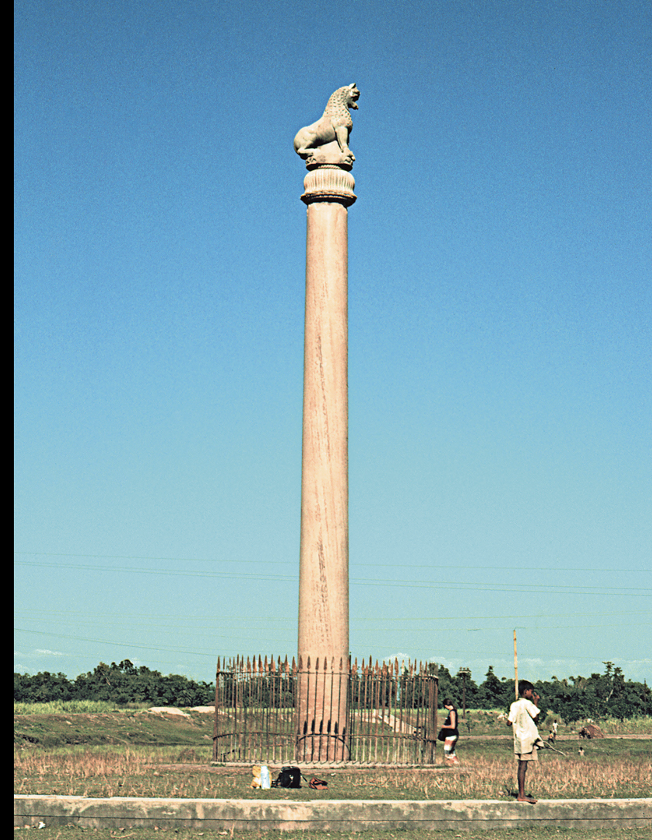
ASHOKAN PILLAR
Lauriya Nandangarh, Bihar, India. Maurya period, c. 246 BCE.
-Ruler Ashoka Maurya had accomplished great deeds
-Historians had difficulties defining him at first until examining the inscriptions on the monolithic pillars in nothern India
-presents himself as a man wary of battle and remorseful for deaths of his politic ambitions. He starts moral teachings, a policy over his empire, which became a rich period for artistic production
-he supported religious institutes especially nascent Buddhist, carves inscriptions in mountainsides and boulders and rock edicts
-Rock edict ”pillars”, very few and in the her of the Maurya empire, mostly at monastery sites along Punjab to Pataliputra.
-Pillars and pillared halls used as Emblems for kingship for persian empire which inspired Ashoka to put his words on columns detached form architectual setting. pillars set setting for south Asian Kingship
-Inscribed in Prakrit,greek,aramaic.
A series of columns dispersed throughout the Indian subcontinent, built during the reign of Emperor Ashoka of the Maurya Dynasty. They are notable for their inscriptions and intricate carvings, serving to propagate Buddhist teachings and commemorate significant events.
Describe the Origin of Civilization in south Asia
-difficult to claim origins broad to diff groups
-both regions have trade networks & same proximity to sea, similar religions-Hinduism,Buddhism,Islam. Strong agriculture production and subject to invasions
-Himalayas evidence of first settlements, earliest civilization on pakistan and northwest India. Indus /Harappan civilization around same time as the old kingdom of Egypt(Minoan), Ur and Babylon mesopotamia-Evidence of trade between Harappan and Mesopotamia
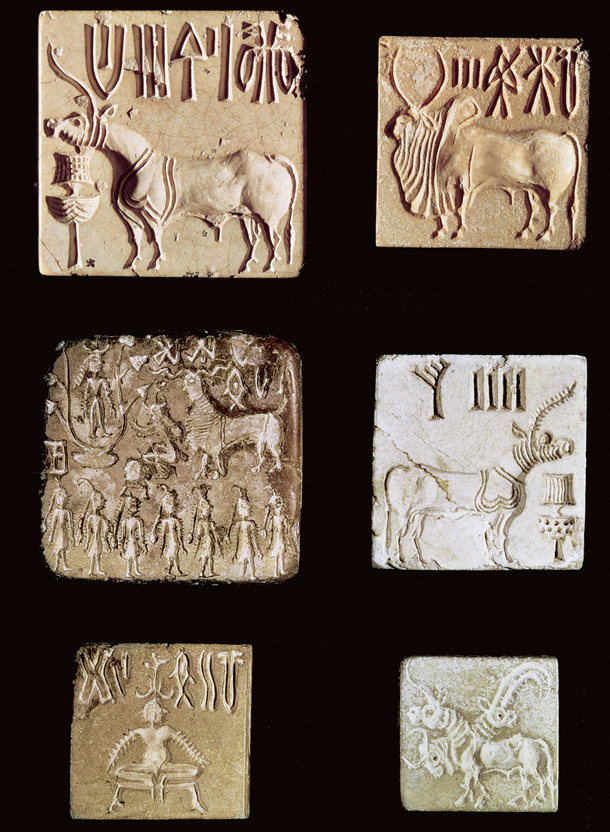
SEAL IMPRESSIONS
A, D horned animal; B buffalo; C sacrificial rite to a goddess (?); E yogi; F three-headed animal. Indus Valley civilization, c. 2500-1500 BCE
-Presence of city mounds and seals(impressions) shows exsistance in the Indus River valley, numerous urban ares have been found in the lower Indus river
-Significant, it shows a language system, pictographic,
-Bottom left (early yogi posture a pose for spiritual purposes, could have influence budhasimn or early Shiva),
Middle left: elaborate headgear stand i row observing goddess and a kneeling worshipper,
-seals give insight into religious customs that may have been prototype for later Indian gods and goddess.
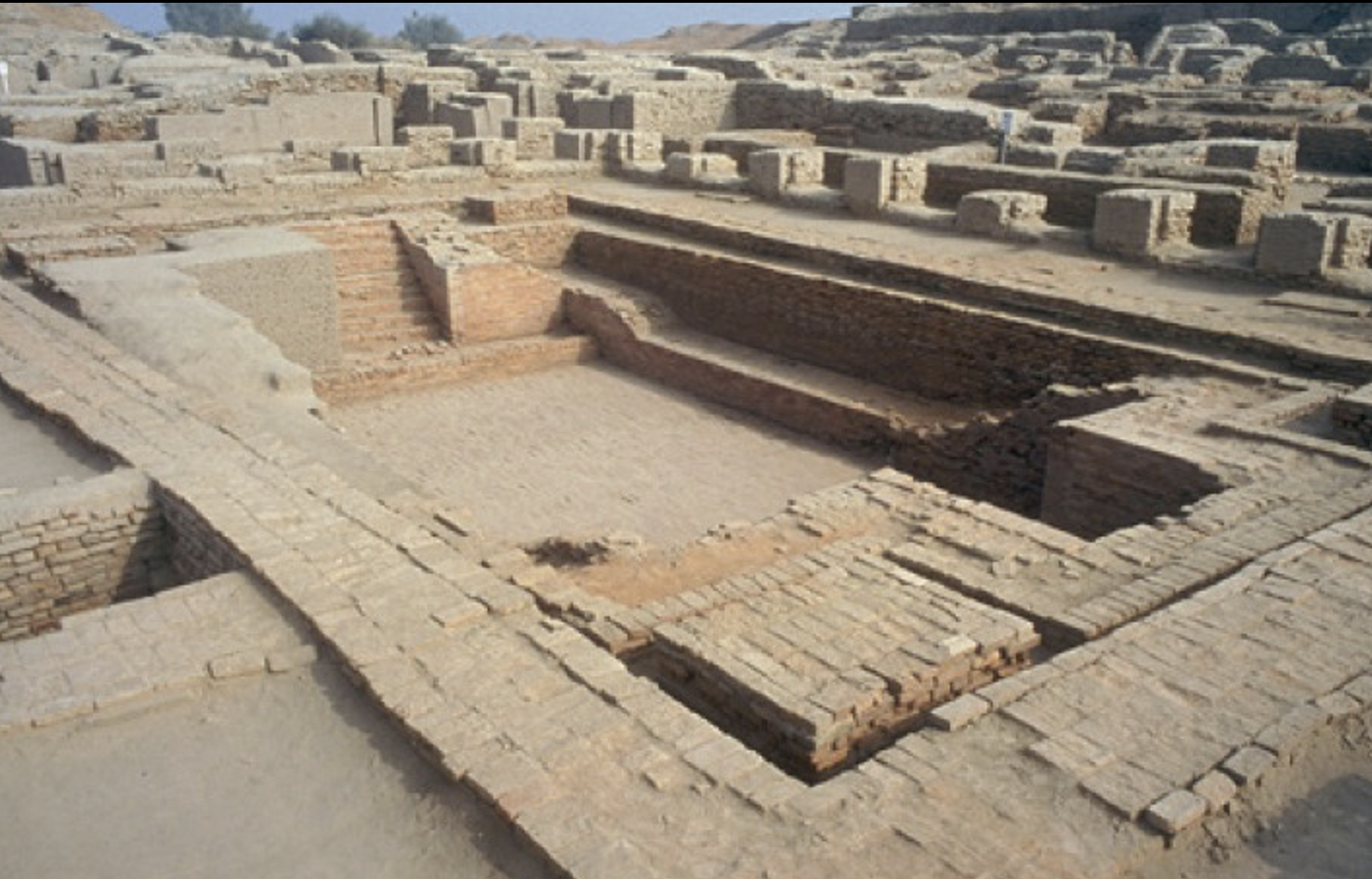
The indus “Hrrapan”Civilization
LARGE WATER TANK, MOHENJO-DARO
Indus Valley (Harappan) civilization, c. 2600-1900 BCE.
-first urban civiziliation. three phases: early(formative , metal work, craft specilization,expansive trading), mature(formation of full fledge urban civizilization, golden age, peak),late(decline in urban life, more spread out)
-starting phases shows unification close streets and grid work : two main parts high(western section for upper class, important building) and low(common ppl , had well and drainage systems), farming depending what they ate, like egypt developed their own system of writing(pictographic , but cannot be deciphered). Large trading between areas around like Ur because of seals found.
-ancient sites of Indus Valley shows coherent cultures because of similar design and constructions.
- Elevated Citadel surrounded by wall, within a water tank. Used for:public baths, ceremonial purposes, ritual use, water tightpool.
-Stretching below elevated area of city, grid-like plan with avenues and streets. Houses usually two stories built around courtyards. Made with Fired brick
-Network of drainage systems for waste and rain water which shows highly advances of technical and engineering skills
-at peak had 20 thousand to 50 population
-uniformity of architecture shows central political but lack of religious and political structure we cannot say how the city was governed.
-because of bath ceremonial action must have occurded for religion ritual,
-Pashupati seal- figure in yogic posture showing resemblance to Hindu god Shiva,
-many theories on why the the civilization , colonization or droughts or other ways
-Arianism brought a new life to indians
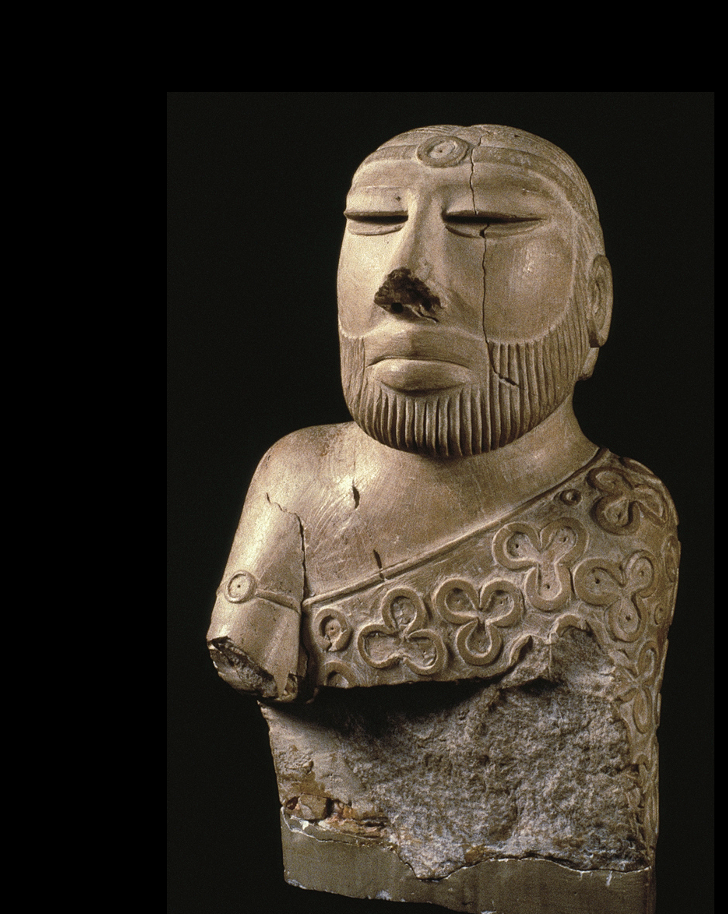
TORSO OF A "PRIEST-KING"
From Mohenjo-Daro. Indus Valley civilization, c. 2600-1900 BCE.
-
trefoil(three-lobed motif),
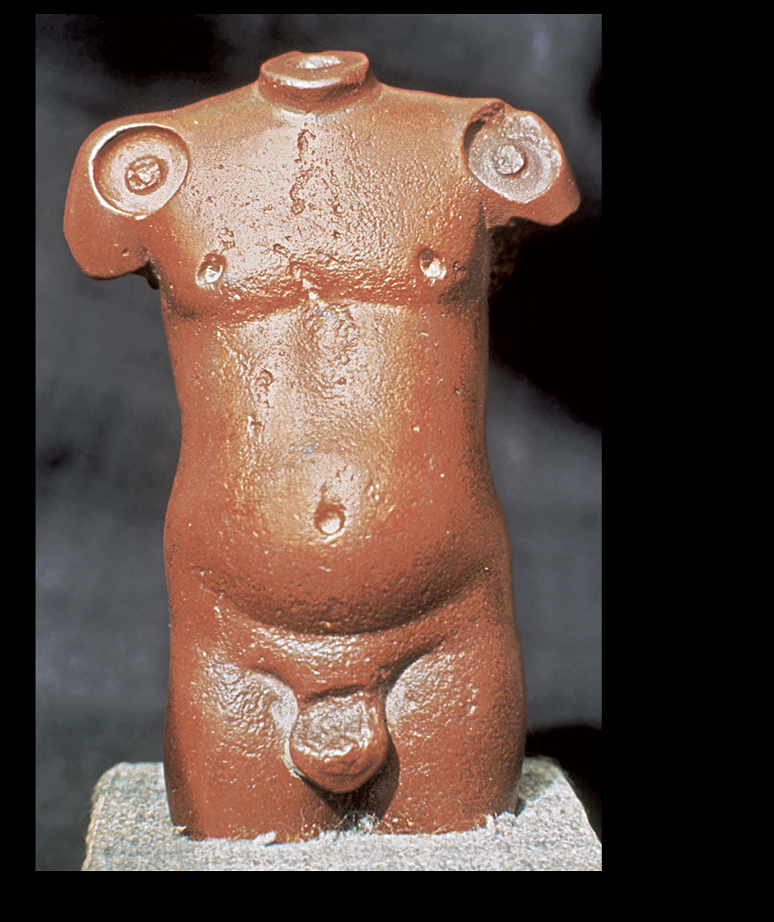
MALE TORSO
From Harappa. Indus Valley civilization, c. 2600-1900 BCE.
Red sandston
-potrayals of actual human form, like like, soft texture of body and light muscles, forecast the essential aesthetic of later Indian sculptures
-indus society decline while nomadic societies emerged
Describe the Vedic Period
During this period (1500 BCE–late fourth century BCE), metaphysical texts known as the Upanishads were written.
They emphasize the relationship between the individual soul and universal soul, or Brahman.
Believers aspire to attain liberation from the endless cycle of existence, samsara
Religious communities arose that engendered basic Upanishadic tenets.
Shakyamuni Buddha's teachings (c. 500 BCE) became the basis for Buddhism.
Mahavira was the founder of the Jain religion.
Both rejected the authority of the Vedas and hereditary class structure of Vedic society.Not urban societey they were nomadic, Jana tribe with gopati,
-Varna system: Brahmins(priests), Kshatriyas(warriors),Vaishyas(artisans), Shudras(peasents)-worship was done outside by fire-Indra was the most powerful,Agni was fire, Varuna was fire
4 vedas: Rig , Yajur(mantras), Sama( verses from Rig but sung), Arthava(compiled after the first three, mantras and prayers to avoid sickness)
veda” to know”
Describe the Flourishing of buddhism an Hinduism
-Shakyamuni Buddha-teacher of Buddhism -Nepal &south India,
4 noble truth which are the base of buddhism:Life is suffering, suffering has a cause which is ignorance and desire, the ignrance and desire can be overcome and extinguished, the way to overcome them is by following the eightfold path of right view rights ; right resolve, speech ,action, effort, etc,.
Buddha is not god but one who sees the nature of the world and no longer subject to samsara
-early form of buddhism is Theravada which is the extinction of Samsara of ones self and attaining nirvana. Mahayana Buddhism foundation is compassion for all beings
-Bodhisattvas”those whose essence is wisdom” and wear princely garb of iIndia and buddhas wear monk’s robe
Following his enlightenment, the Buddha ("Awakened One") gave his first teaching in the Deer Park at Sarnath.
Here he gave the Four Noble Truths which are the foundation of Buddhism.
Life is suffereing; this suffering has a cause, which is ignorance and desire; this ignorance and desire can be overcome and extinguished; the way to overcome them is by following the eightfold path.
Describe the Maurya Period
During the reign of the third Maurya king, Ashoka Buddhism became a religion to extend across the entire empire, region known as magadha.
There were monolithic pillars set up primarily at the sites of Buddhist monasteries, including the Ashokan pillar, inscripted with rules of dharma(keep the universe from falling into chaos), later kings upholded this law, top of pillar were elaborate shaped animal capitals shaped from sand stones, pillars/royal standards symbolized axis mundi” axis of the world”, joining earth with cosmos (human and celestial realms).
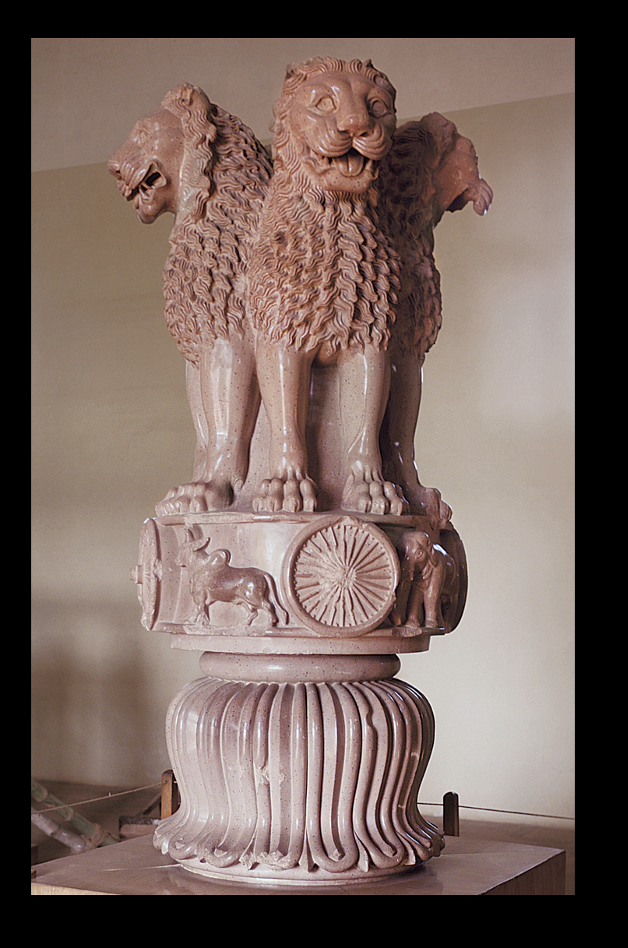
LION CAPITAL
From Ashokan pillar at Sarnath, Uttar Pradesh, India.Maurya period, c. 250 BCE. Polished sandstone,
-located at Buddhas first sermon
-Represent 4 addorsed (back to back) Asiatic lions with open mouths standing atop circular platform depicting a bull, horse, lion, elephant separated by large chariot wheels. Base is an inverted lotus blossom. Deep cuts create active light play which is visible even at the top of the pillar.
-”lion’s roar”, “wheel of law”,Buddhas first teachings to chariot wheel and sermon the first push to set the wheel rolling across the world
-holds politic association-lion shows kingship ;the elephant, horse,bull, are emblems of worldly and military power. Wheel motifs as chakravartin(universal king, wheels go everywhere unimpeded).
Ashoka represented as worldly might oh his empire with moral authority of buddhism. There was a large wheel on top , now lost.
FEMALE FIGURE HOLDING A FLY-WHISK
From Didarganj, Patna, Bihar, India.
Probably Maurya period, c250 BCE.

-along formal institute of Jains, Brahmins, Buddhist shows host religious practices of gods of village overseeing health, wealth, and fertility.
holding “chauri”, is deity, representing a yakshi(spirit associated with the reproductive and productive forces of nature) , female association with procreative abundance,bounty,
Conveys the yakshi authority through pose, volumes of form, strong ornaments and dress. Lustrous polish , a special feature in Maurya sculptures.
ELEMENTS OF ARCHITECTURE: Stupas and Temples
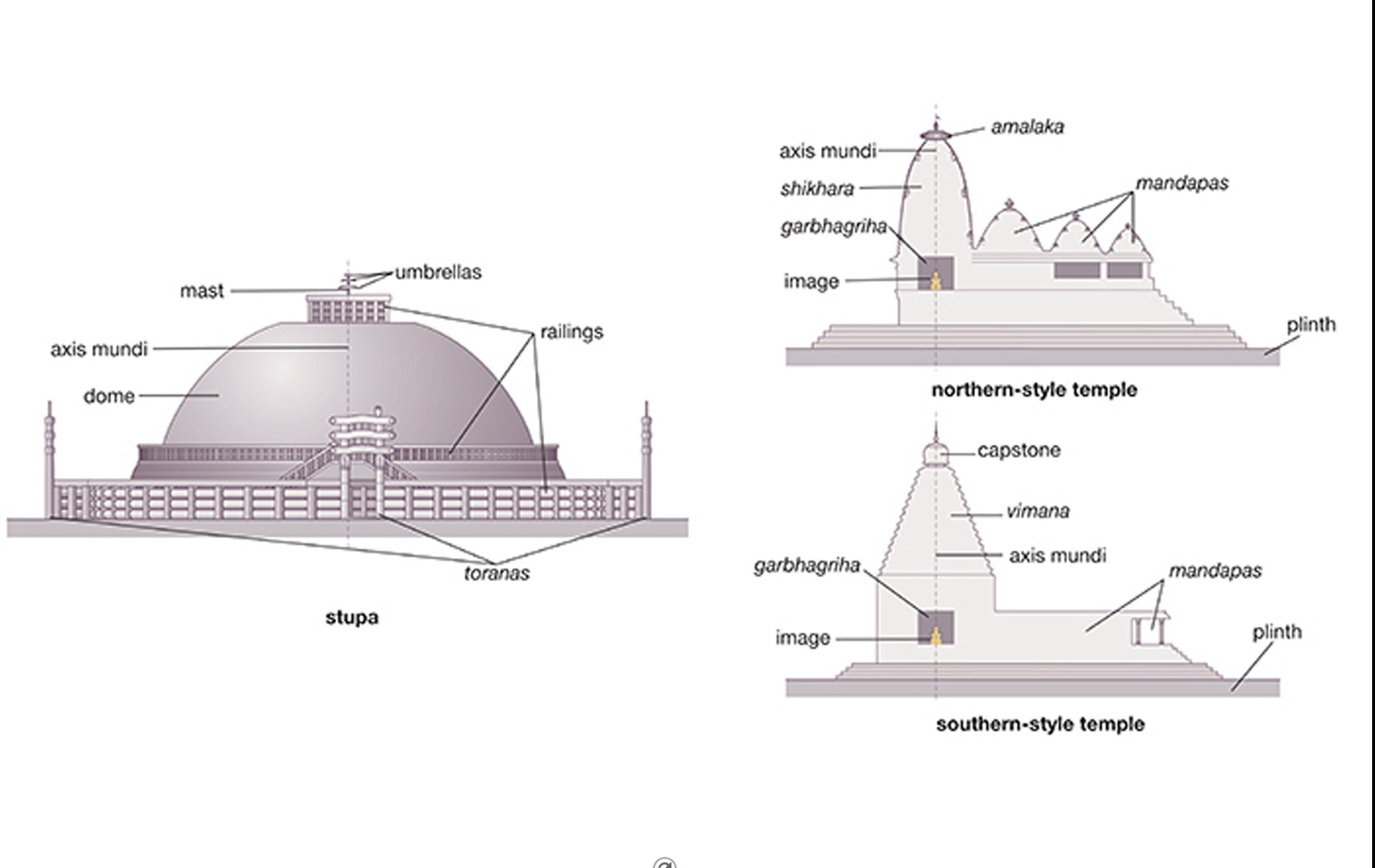
-Buddhist architecture mainly consist of Stupas and temples at monastic complexes containing viharas(cells and common area for monks).
-Monuments may be Structural(built ground up) OR rock cut( hewn out of mountains)
-first stupa to house buddhas remains after cremation. Relics were devided into 8 and given to kings who then encased remain in burial mounds. Venerated as his body, expression and attainment of nirvana-method of veneration to walk clockwise around stupa
-Stupas-plan carefully calculated mandala(diagram of the cosmos as envisioned in buddhism). derive from burial mounds and contains relics beneath a solid(connected to buddha or disciples), dome shaped core. Major stupas contains large railing around to create path for ritual circumambulation. Railing is punctuated by gateways called toranas aligned with cardinal points of compass. Stupa sits on round or square terrace , stairs lead to an upper circumambulatory. Top of stupa a railing define a square, from center rises umbrellas. Open to all for private worship.
-two hindu temple types Northern and Southern
-North: Shikhara(entire towerlike superstructure, curved inward, sloping steeply near peak). shikhara crowned by amalakas. Inside are mandapas (halls) leading to sanctuary(garbhagriha) which contains a sacred image. Axix mundi imagined to run vertically up from the cosmic waters below the earth through the image and out through the top of the tower.
-south-angular steplike terrace, shikhara only refers to its finial(the uppermost member of the superstructure).
-jain architecture consist mainly of structural and rock cut moneseries and temples common with biddhist and hindu.
STUPA 1 (THE GREAT STUPA) AT SANCHI
Madhya Pradesh, India.
Founded 3rd century BCE; enlarged c. 150-50 BCE.
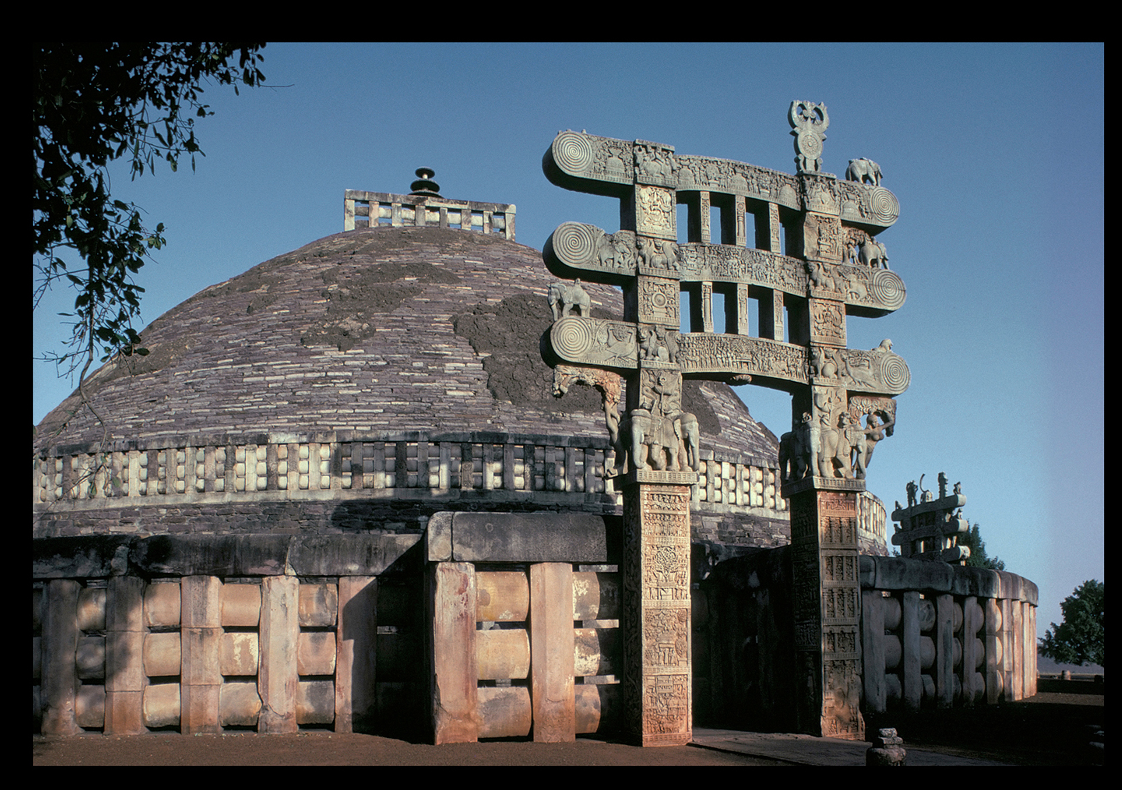
-time of Ashoka. Part of monastary complex crowning a hill. Mid century BCE enlarged to its current size and surrounding stone railing was constructed, 100 years after carved stone gateways were added.
-built from rubble and dirt, faced wth dressed stone, covered with shining white lime plaster and powdered shells. railing surrounds a circumambulatory path-ground level. south has staircase to 2nd circumambulatory. On top mounds a squrae enclosure with another railing within is three stone disk”umbrellas” are interpreted as parasols used to shade kings or “three jewels of Buddhism”(the Buddha, the law, the monastic order.
-Railing provide protective boundary and ritual path around. Carves octagonal uprights and lens-shaped crossbars, simulate wooden railings. 4 stone gateways”Toronas”, aligned with 4 cardinal directions punctuate the railing. Inscription on south gateways by ivory carvers from Vidisha, another inscription on the same torona specifies a gift during the reign of King Satakarni of the Satavahan dynasty. Most inscriptions from donor of all walks of life. Gateways are the only peice ornamented with sculptures.
-4 gate support 3-tiered array of architraves with crossbars carved with stories from Buddha’s past life, and Jake tales(stories of Buddha’s past lives).1st Relief sculptures show buddha not in human form, represented by symbols like his footprints, enlightemnment seat/plank(shows wider practie than buddhism). 2nd shows the great departure covering the outer surface of curving architrave of the eastern torona.
Describe the period of the Shunga and the early satavahana
-demise of Maurya empire , India returned to rule by regional dynasties. Two important dynasties between 2nd century BCE and early century Ce.
shunga-central india
Satavahana-central then south India
The Great Departure
East torana (exterior middle architrave) of Stupa 1 (The Great Stupa) at Sanchi.
1st century BCE. Sandstone.
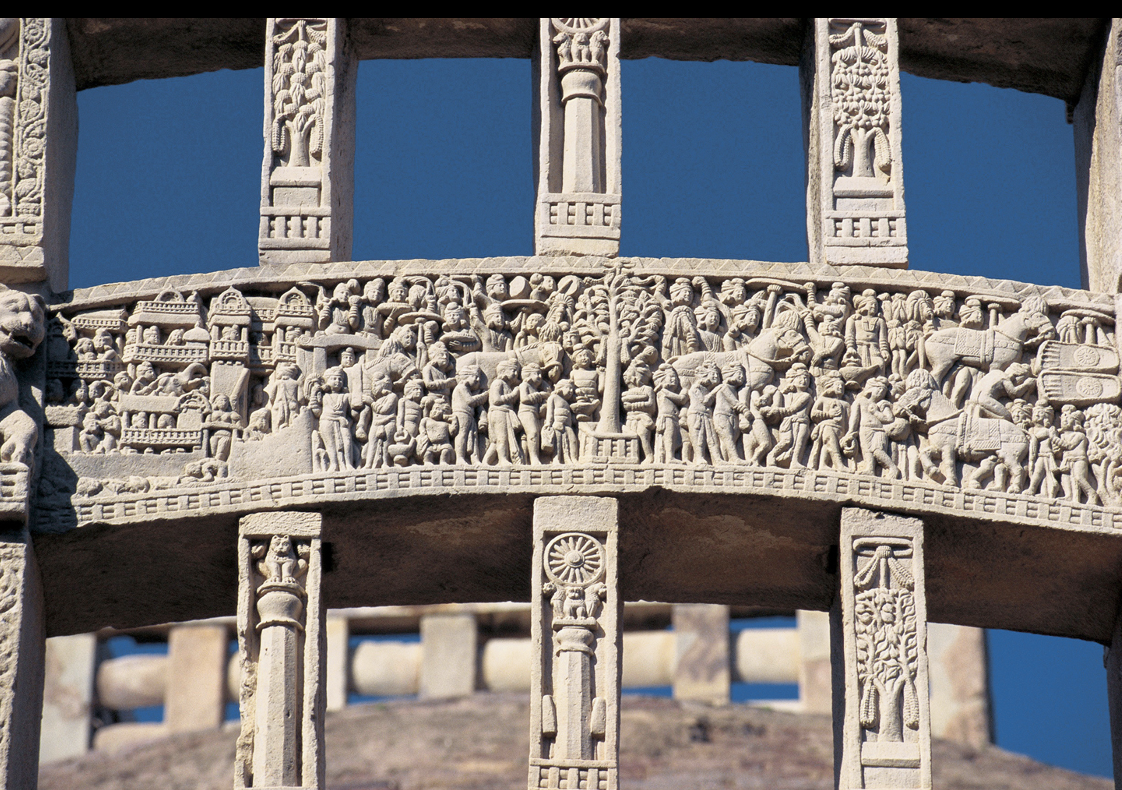
YAKSHI BRACKET FIGURE
East torana of the Great Stupa at Sanchi.
Sandstone,
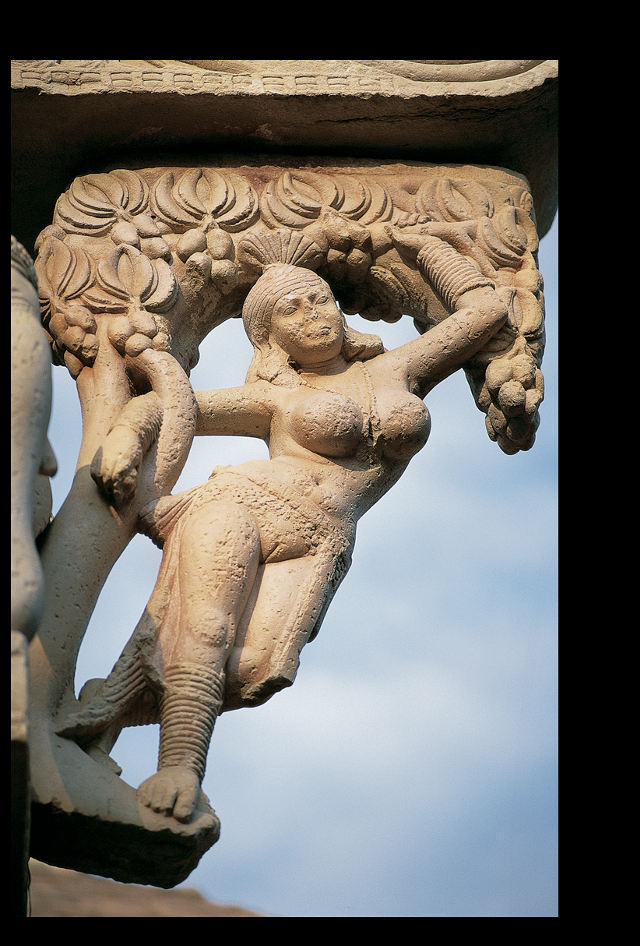
-great departure: narrative of the Buddha”prince Siddhartha” leaving the palace to give up his royal place to become an ascetic. Het tells his charioteer channa. Budhha mounths his horse and leaves at night while gods(yakshas) cups the hooves of the horse for a silent retreat and supports his spiritual quest, some same they carried the horse over the gate.
-shows prescence of prince with the rideless hors. Actions are show geographicaly as the tree in the middle shows the transition into forect settint. Yakshas follow the creature when accompanied by the prince then the charioteer is shown turning back leaving shakyamuni to begin his life as an ascetic. Footprints show dismount place of prince Siddharta
-Toranas decorated with Yakshis and yakshas(male) , rider on real and mythical animals,and buddhist wheel.
-Yakshi are finest female figures of indian art. The maurya one was formal and more rigid where as this one is leaning daringly into space supported by one leg. appears almost nude emphasizing her form. hangs from mango tree reassure the bounty that associates with yakshi deities. On top of doorway show her role as a guardian(shows inclusiveness) , deities even benefit from buddha’s teaching.
CHAITYA HALL, KARLE
Maharashtra, India.
1st century BCE-1st century CE
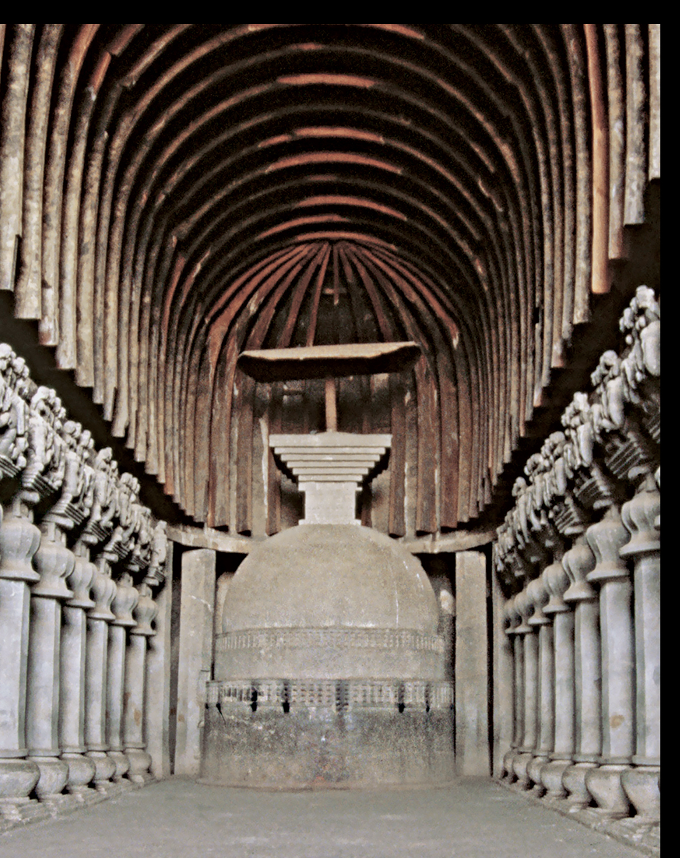
-cavelike sanctuaries were hewn out of stone plateaus(Deccan). For Jain and Buddhist monks, carved from tope to bottom, details in stone. Cool dark interior and echo magnifies the slightness of sounds heightened the awareness in the halls.
-two types of rock cut out used by monastic communities : vihara(monks living quarters) and the chaitya(sanctuary).
-Outside:the hall is the largest and most developed buddhist work. Entrance with columns that used to support wooden facade infront of stand pillars inspire by Ashoka’s. Carved vestibule walls with balcony similar to a multiple storied palace. Base of side walls are elephants that support the entire structure on their backs. Horshoe shape opening.
Inside: three entrances allow you to enter. Flanking the doorways are sculptures of mithuna( couples that evoke harmony and fertility). Interior wall caved in barrel vault ornamented with wood. interior and exterior were once painted . Pillars make a pathway circumambulatory around the stupa. Columns seperate main aisle,have base pots and step on pyramid of planks. The capitals depict pairs of kneeling elephants as mithuna couple. Sculpture present nobility , stupa is simple and umbrella at the top , sculpted from rock of the cliff.
Describe the Kushan period
KING KANISHKA
Uttar Pradesh, India. c. 2nd-3rd century CE.
Sandstone
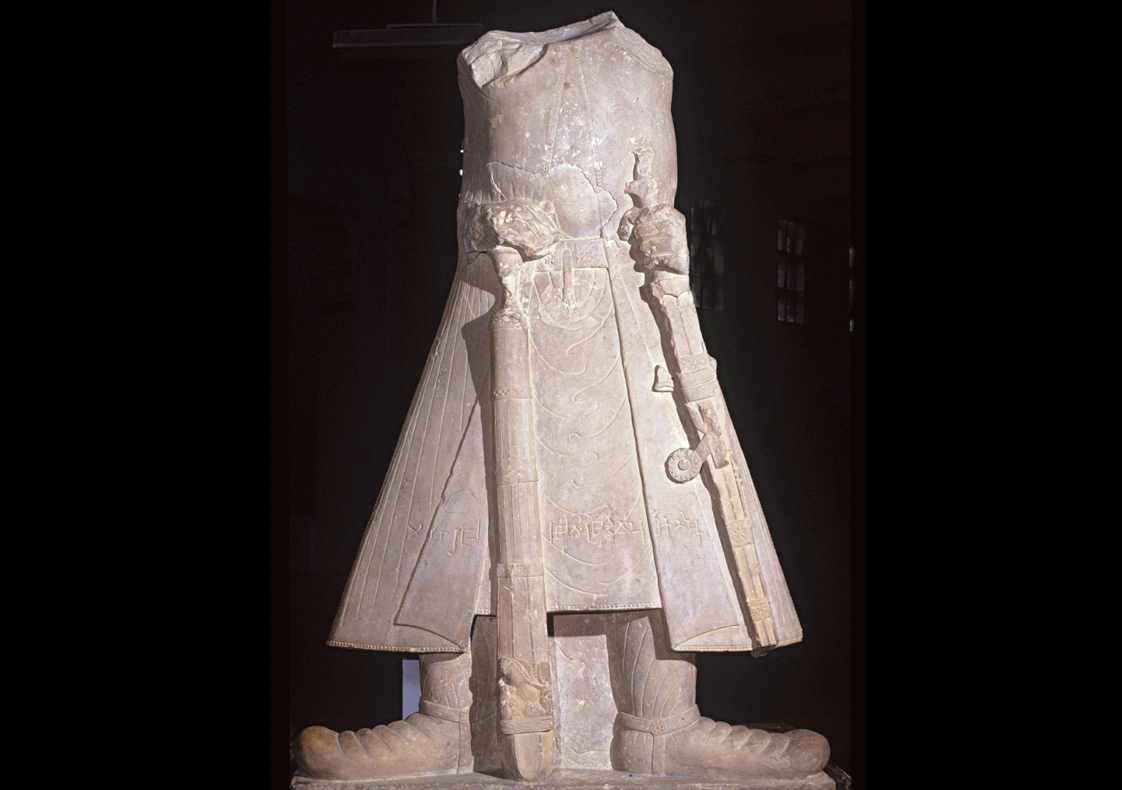
The Kushans were heavily-bearded warrior kings who made widespread use of royal portraiture on coins and in sculptural form.
King Kanishka is one of the kings used in sculpture.These rulers were eclectic in their religious views and supported a wide range of religious institutions.
“ the great king,king of kings”
-innovative figural art started to blossom, first depictions of Buddha, distinctive styles in Gandhara and Mathura.
-Kushan is distinct but share characteristics: wears monk’s robe draped over left shoulder and body, lakshanas(32 distinguishing marks) which include; golden body, arsm reaching to knees, chakra on the palm of hands and feet, urna(mark between eyebrows. Wore heavy earings which elongated earlobes, ushnisha (protuberance on top of head, bun which symbolizes enlightenment),
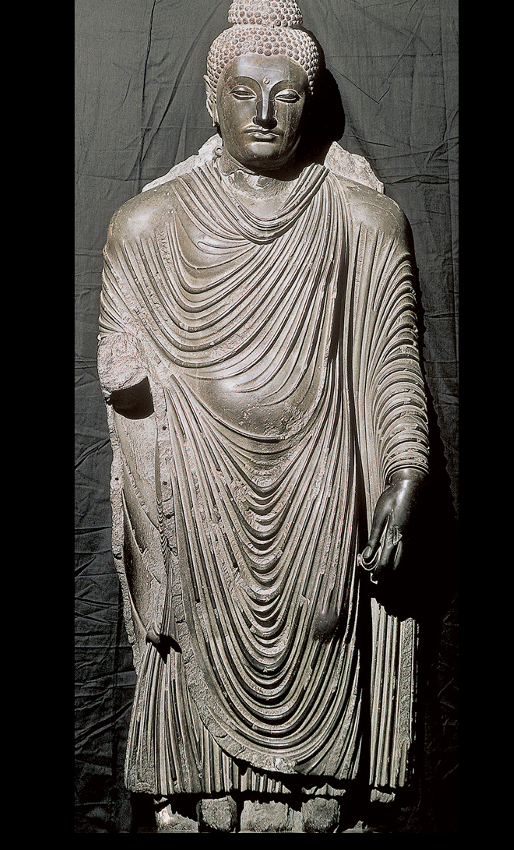
STANDING BUDDHA
From Gandhara, Pakistan. Kushan period, c. 2nd-3rd century CE.
Schist,
Wwhat are the conventions of the Buddha?
-Gandhara style-combining helenistic,persian,indian styles in which portrayed the Buddha in an athletic figure.
Body can be seen through contours of garments is broad and massive, heavy limb and strong legs. Left knee bends slightly
-robe is a characteristic of Gandhara manner,naturalisctic cloth folds for a rhythmic pattern of heavy creases, folds on left arm , below half is shaped in u form, strong pattern of drape brings life and power. Resembles togas of roman sculptures.
Gandhara regions relationship with hellenistic world brought mediterranean feeling to art. Hellenistic culture thrived by Bactria when greeks were under Alexander the great and reached borders of India . Gandhara near east west trade roites of roman culture in the near est.
Varada and abhaya mudra
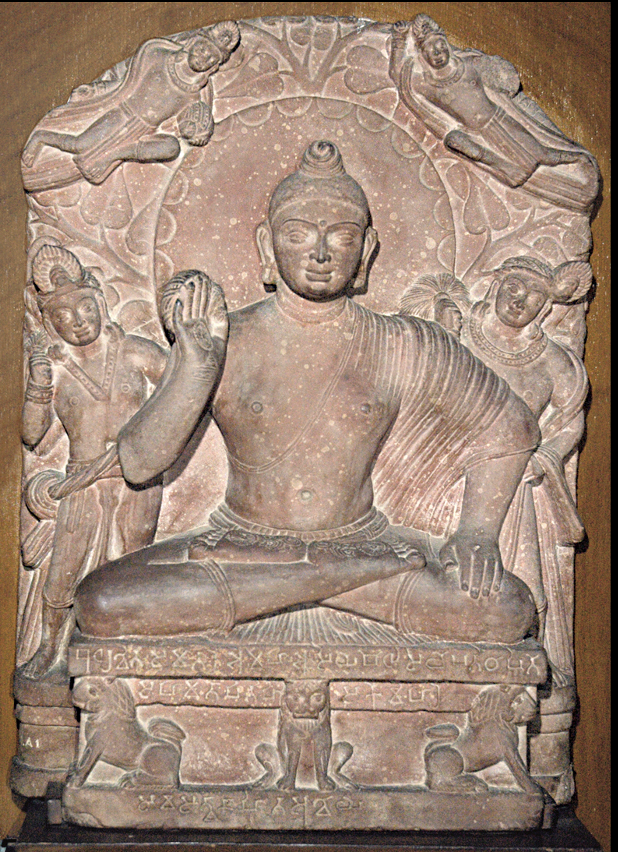
BUDDHA AND ATTENDANTS
From Katra Keshavdev, Mathura, Madhya Pradesh, India.
Kushan period, c. late 1st-early 2nd century CE.
Red sandstone
the Mathura style:not alined with roman art.Representations of yakshas(male nature deities). Frontal stance, broad shoulders, wide eyes.
-Stele red sandstone with creme spots. High relief, seated buddha with 2 attendants. Right hand is raise which means” have no fear”. Mudras to communicate. Urna, ishinisha, impression of wheels on palm and soles. Halo behind head with radiating light, branches and pipal trees with two celectial beings.
-Robe is suited to the warm weather of Mathura, robe is tight so we can see the flesh, pleats of robes show abstraction which is also shown on face. Face is geometric and rounded open eyes. Natural body. Buddhas alert and outward gaze , concentrated energy draws spiritual power on physical form.
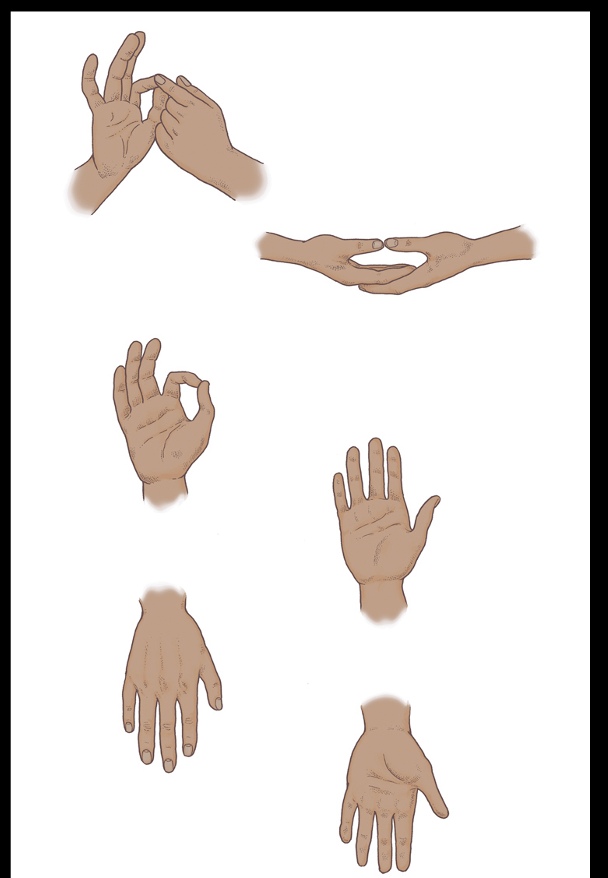
What are Mudras?
Name Mudras
sankrit for “signs”, ancient symbolic hand gesture, first appear on manual on dance now a physical expression of state of being. Iconographical in Buddhism. Used during meditation to invoke a state of mind.
-Dharmachakra: as if subject is counting on his fingers, setting the chakra(wheel) of the dharma(law) in motion, hands at chest
-Dhyana: meditation and balance, path towards enlightenment. Hands on lap, lower hand is maya upper is nirvana, enlightenment and release from the world
-Vitarka : variant of Dharmachakra , intellectual debate. thumb and finger touching
-Abhaya: reassurance,blessing,protection”have no fear”.
-Bhumisparsha : calls upon the earth to witness Shakyamuni Buddha’s enlightenment at Bodh Gaya.
-Varada: gesture of charity, fulfillement of all wishes.
Define Hinduism
Hinduism is not one religion but many related beliefs and innumerable sects.
reform of older Vedic undertaken by Brahmin who were unsatisfied with the older systems of rituals
Each Hindu sect takes its particular deity as supreme.
The most popular deities are Vishnu, Shiva, and the Great Goddess, Devi.
Samsara(reborn into higher positions escaping life, death ,reborn
Vishnu-regal god who works for order and well being of world, blue skinned 4 arms
Shiva- creative and destructive, light and dark, male and female, ascetic and family man. Symbol is Linga or yoni. Lord of dance
Devi- controls riches and fertility. Embodiment of cosmic energy
Central deities , puja(forms of worship) darshan(beholding a deity) performed to liberate from samsara.
VISHNU TEMPLE, DEOGARH
Uttar Pradesh, India.
Gupta dynasty
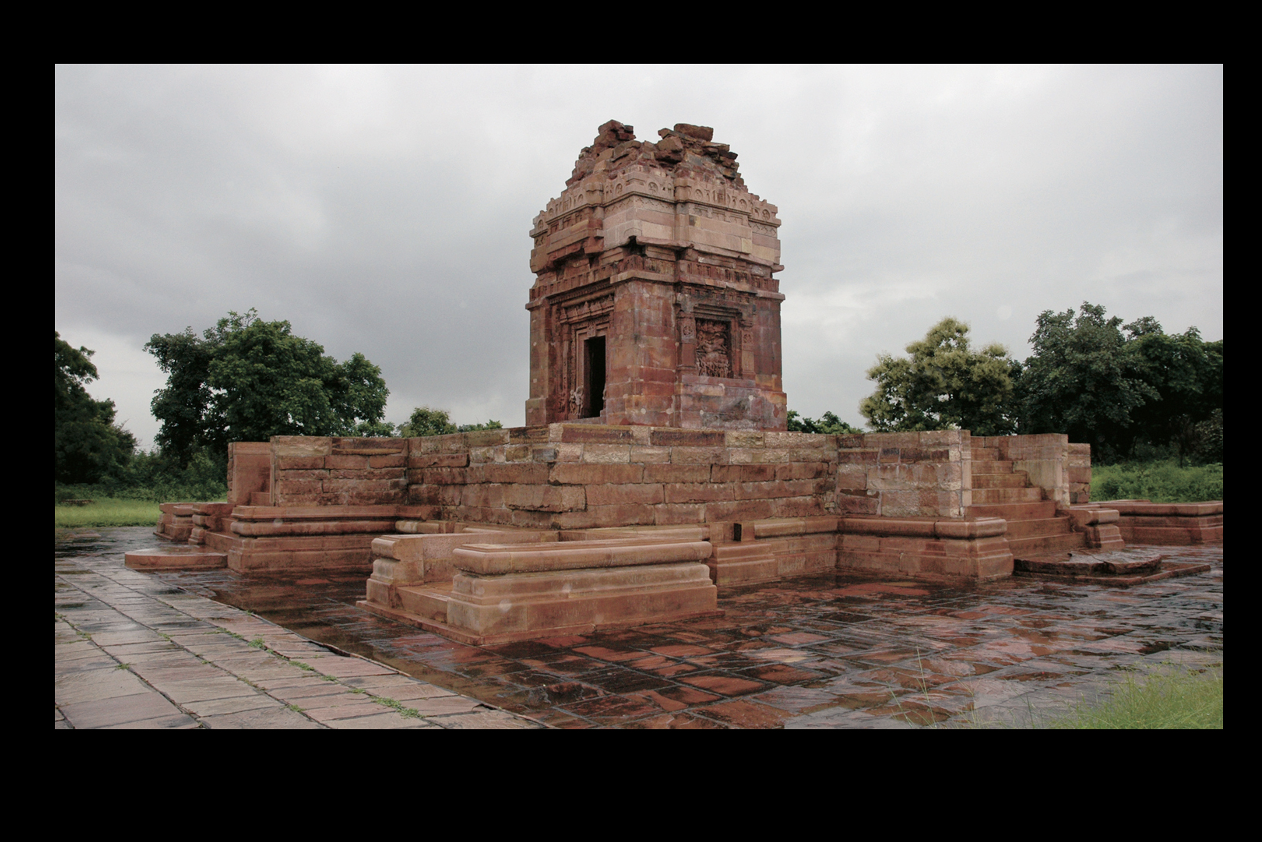
VISHNU LYING ON THE COSMIC WATERS
Relief panel in the Vishnu Temple, Deogarh. c. 530 CE.
Sandstone
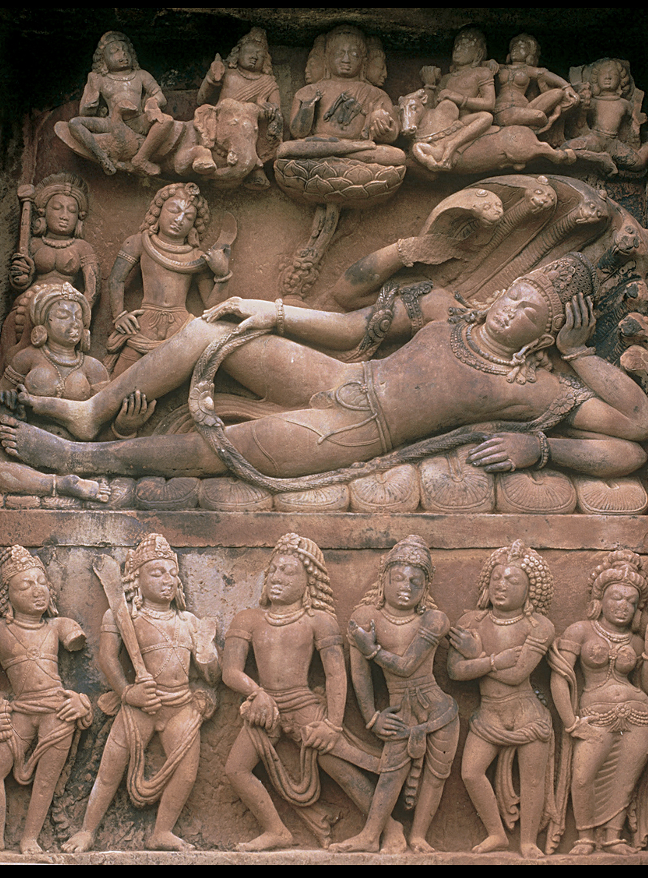
Gupta period was peak for Hinduism, vedic sacrifices termed Hinduism.
-temple-earliest nothern temple in ,site pattern on mandala. Shikhara and most of tower has crumble therefore cannot determine original shape, cut stone made for impression of mountain which is metaphoric for hindu temples. has garbhagrina(womb chamber) center of mandal with sacred tavern.
-relief sculpture of vishnu appear as windows symbolically to let light of deity out of temple. Vishnu sleeps on serpent of infinity, Ananta body goes into space. Shakti(female energy) personified by goddess Lakshmi holds foot, Vishnu dreams universe into exsistance. Lotus springs from navel and god Brahma emerges four headed and turn to univers”may i become many”. Vishnu has 4 arms and size has omnipotence, richly ornamented.
Gupta style is clear in smooth perfected shape of the body and lavish jewlery including cylindrical crown. Four figure on bottom right show his 4 attributes, they stand ready to fight evil of two left figures that threaten Brahma and threaten creation.
potrayes birth of universe and apperance of evil in 3 registers. indian expression shows story before our eyes in drama acts by gods in superhuman form.
BUDDHA PREACHING HIS FIRST SERMON
From Sarnath, Uttar Pradesh, India. Gupta period, c. 465-485 CE.
Sandstone
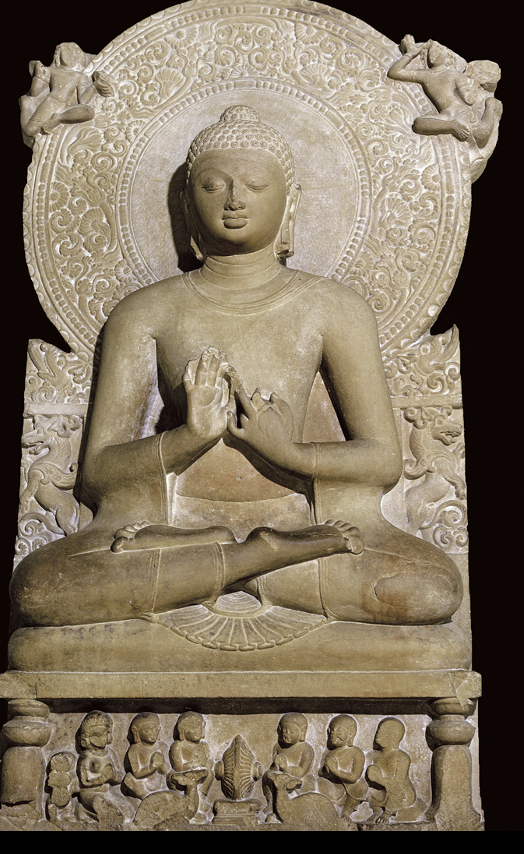
-Buddhism thrives during Gupta period gandhar style decline and Mathura style rises Buddhist visual forms over north India like Sarnath.
Sarnath Gupta style, yogic posture , first sermon teaching posture. Devotees with wheel faces toward viewers are joined by divine being flying above. No folds in robe. Body visible, gracefull and slight. only a few line of garment are sharp and elegant face. Downward eyes show otherworldly inersection with human posture. Hal. has circle of pearls and foliage.
BODHISATTVA
Detail of a wall painting in Cave I, Ajanta, Maharashtra, India.
Vakataka dynasty, c. 475 CE
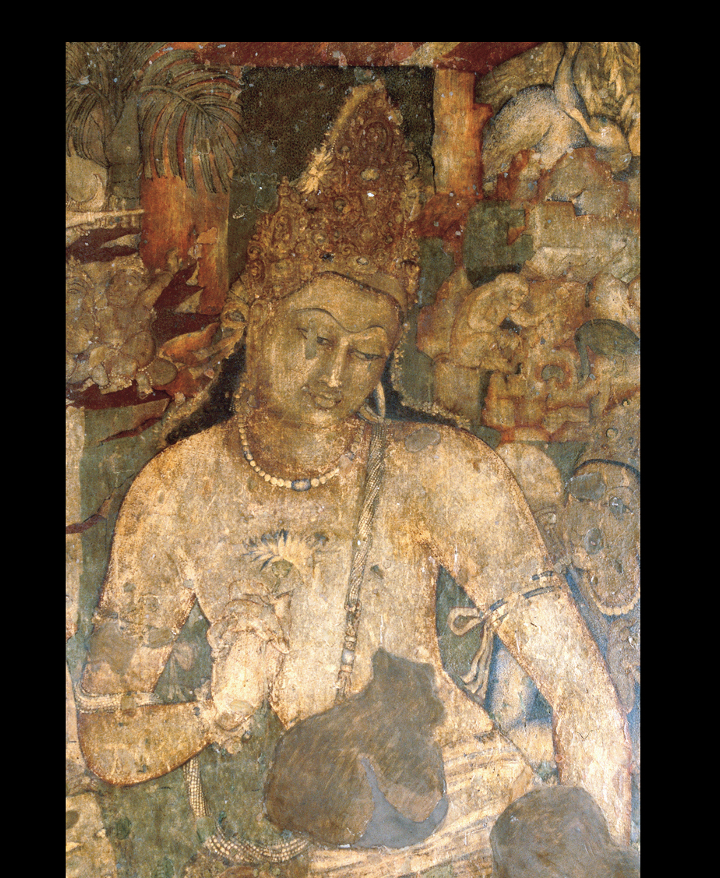
Vakataka subject to gupta ruling, new phase of construction at the Ajanta monestery. Each cave of 20 had own patron with finest rock cut architecturen anywhere. Wall painting are refined art given us a sense of their time. Large vihara hall with monks chambers around and buddha shrine. painted with mineral pigments
-flank entrance of chamber. BODHISATTVA= enlighten being who postpone nirvana and buddhahood to help other achieve enlightenment. Differetn than buddha with princerly garments. Adorned with delicate ornaments: jewled crown, large earings, pearl necklace, armbands, bracelets. Striped cloth on lower body. Bending posture and serene gaze give sympathetic attitude. Lotus flower give identity of bodhisattva Avalokiteshvara. Naturalistic style balances outline and colour tone. Outline is major element of Indian painting; tonal gradation help 3d form wth lighter tones for nose, shoulder, chest. Jewels light up from tonality of figure. Realest detail balanced with languorous form. also common in the sarnath statue.
Describe other development in the 5th to 7th century
-Fall of Gupta, north Indian empires struggles stability , 6th century power shift to south where expansive empire emerged. Got wealthy on trade, trade expansion along with religious ideas. Competition between Buddhism and hinduism, more receptive communities with Biddhists
STANDING BUDDHA
Bamiyan, Afghanistan. c. 5th century CE.
Sandstone coated in stucco
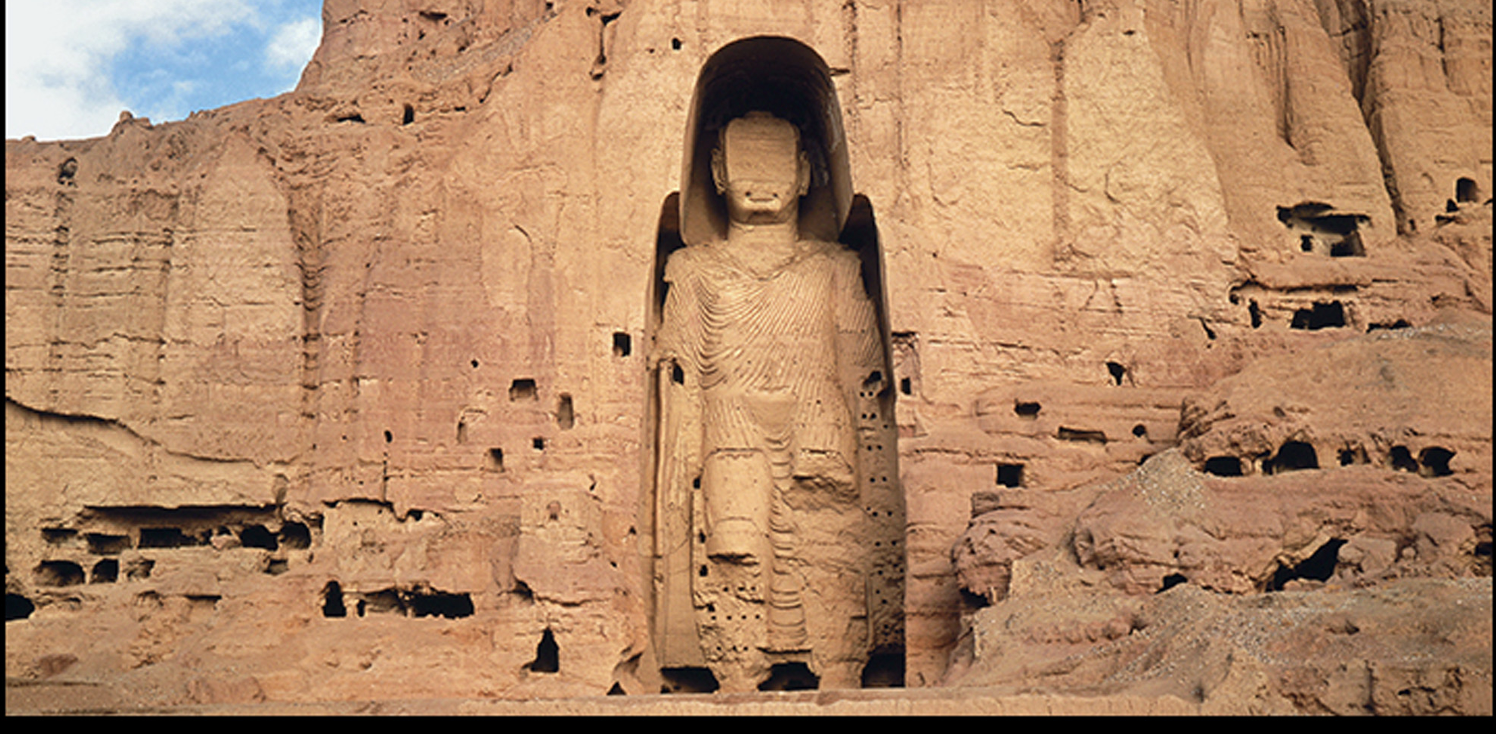
Bamiyan Buddhas
South Asia where Gupta feudatories flourished also while Bamiyan northwest of Kabul,Afghanistan, also flourished, west of treacherous silk road it was haven and crossroad on lucrative trade routes from China to the west. There, two huge Buddhas were carved from a rock of a cliff. Dated before chines pilgrim. Buddhists travelers gave prayers of safety and gift of thanks. Right side of smaller figure, pilgrim could walk up stairs within cliff to shoulder, then, look into vault of niches of painting of son of god, metophoric pilgrimage to heavens. Can circumambulate at head level and go down from left side of head. by stairs. Model for rock cut sanctuaries in China, Yungang. Taliban demolished them in 2001.
SIGIRIYA
Matale District, Central Province, Sri Lanka.
5th century CE.
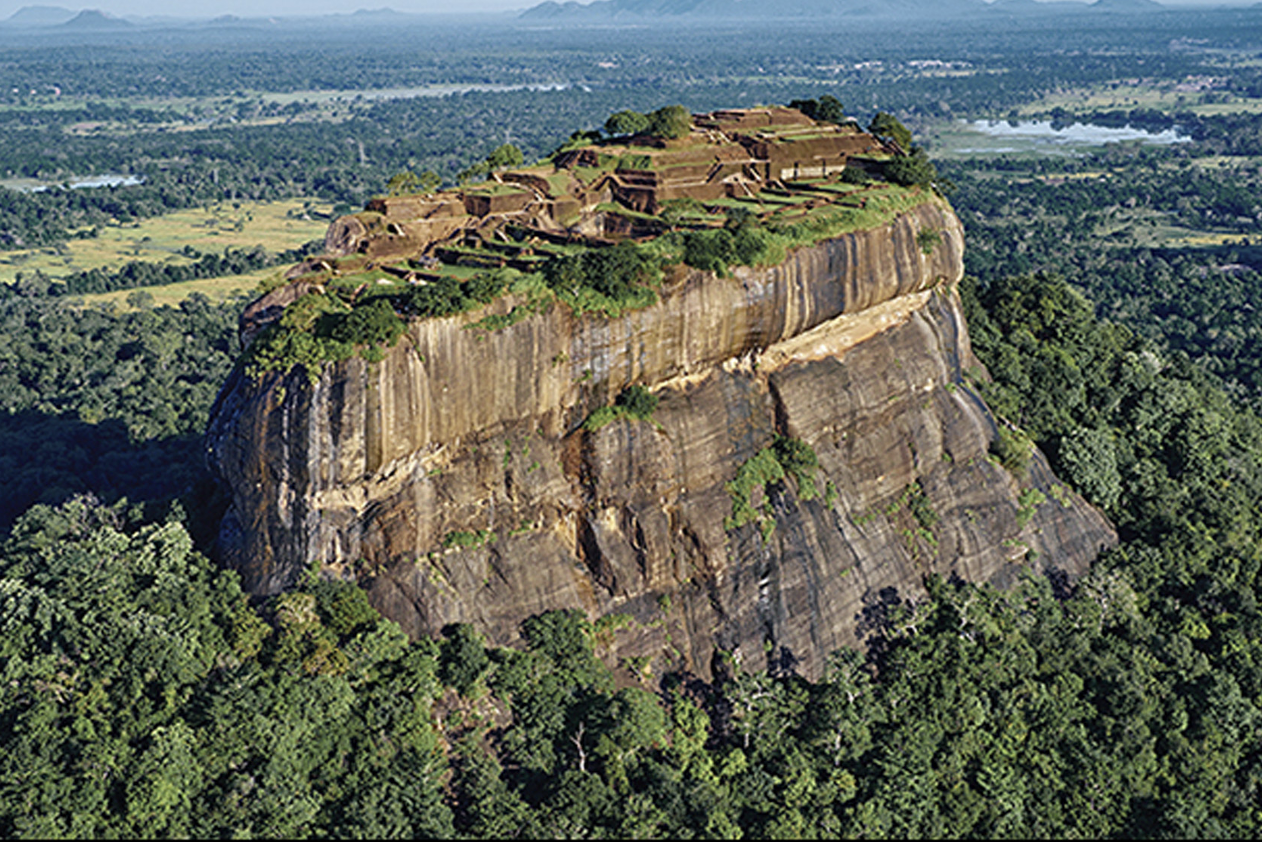
-built on dramatic plateau that rises ubruptly that rises above the forest canopy, in northern Sri Lanka. According to chronicles ,built by King Kassapa in late 400s ce after he usurped throne from his father and drove off his brother.
Visitors pass through moat then elaborate gardens then begin ascent. At base , staircase is through massive chest of sculpture of lion, only feet now exist. While climbing their greeted by painting of Heavenly maiden(image below) moving among cloud, then to top of plateau. Foundation (cisterns) and few sculpyure remains, imposing splender and elavation. Kassapa after 11 years dethrone by brother Moggallana with army. Moggollana gave Sigiriya to Buddhist monastery.
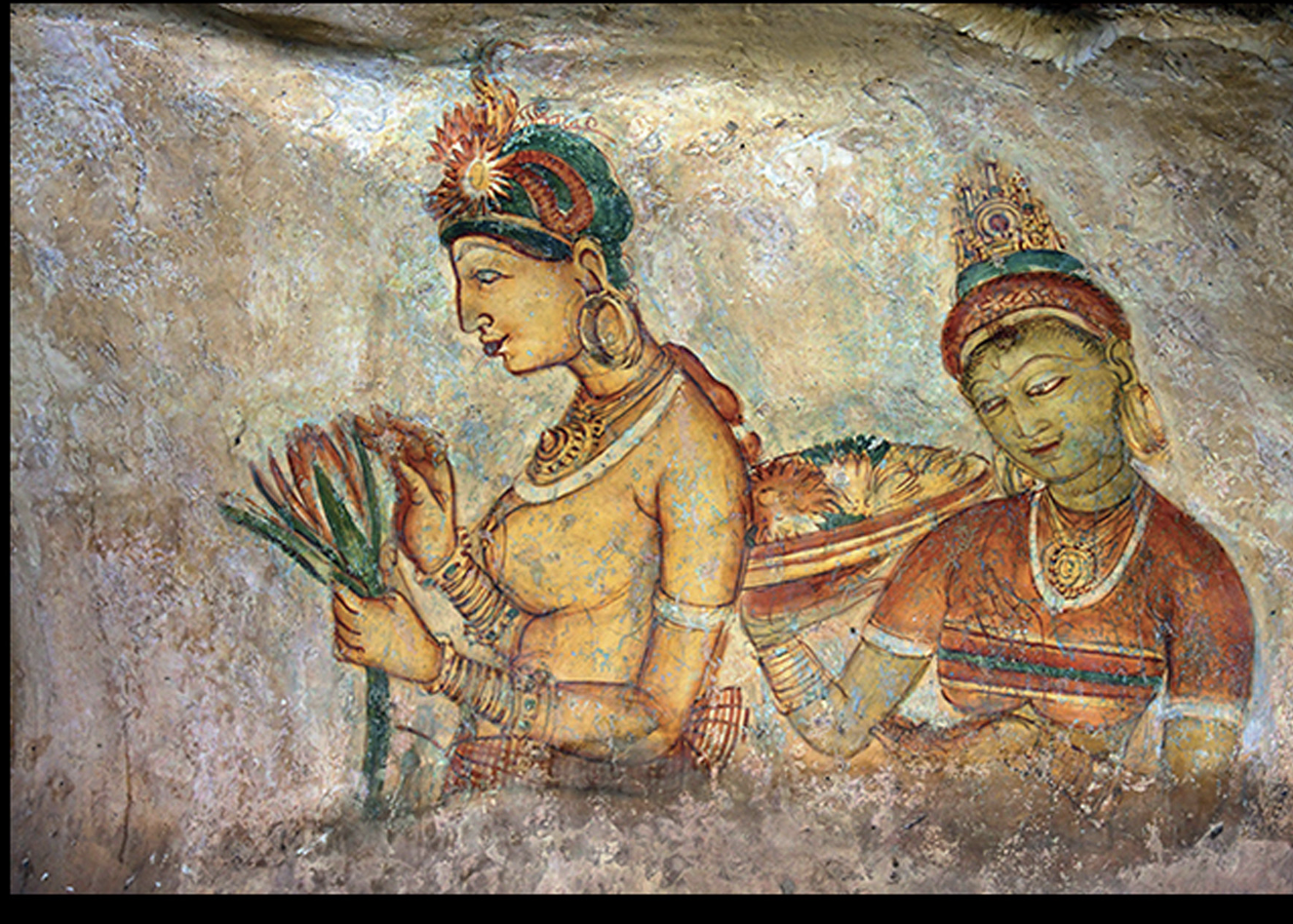
CAVE-TEMPLE OF SHIVA, ELEPHANTA
Maharashtra, India. Post-Gupta period, mid 6th century CE.
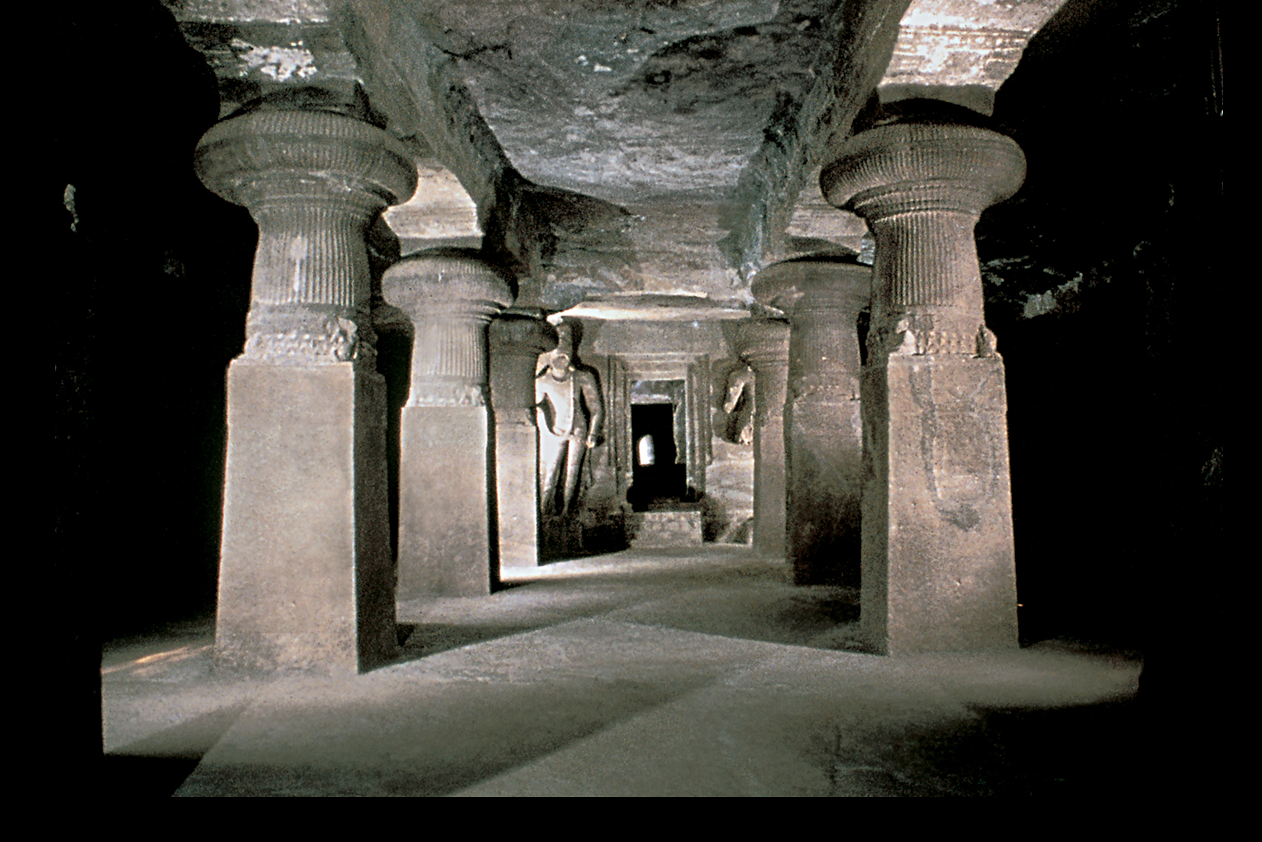
-temple of Shiva at Elephanta
Shiva takes on objects and forms , gentle and wild. Greta Yogi who dwells long in meditation in Himalayas, also, husband who make love to goddess Parvati for eons at time, slayer of demons, cosmic dancer who dances destruction and re-creation of the world. Hindu rock cut architecture. Three entrances. Interior along two axes. Entrance is the only source o light, which result in back lighting which gives mysterious and confusing complexity.
eat-west axis, cut pillars support ceiling and beams but not structural. Pillars are orderly rows , form of overlapping mandalas both symmetric and irregular shape. Pillars are unadornes, square base that is half the height. Top has cushion capita and circular column. Column and capital are fluted. Has linga shrine a colossal standing guardian figure flank all four entrances. central of shrine is linga(abstract symbof Shive, presence of unmanifest formless on/Brahman. Linga is synonymous with Shiva, seen at every shiva temple and shrine.
North-south wall has relief of huge bust of Shiva, represents Sadashiva (eternal Shiva). 3 heads rest on upper body, 5 head implied(4th behind, 5th never depicted). Head in front depicted as Shiva deep in introspection, massive and broad, barely delineated eyes, heavy lower lip suggest gods serious depths. Lordly and majestic, support jeweled crown with design with matter yogi hair. Left shoulder depicted as female with curled har and pearled crown, his creative nature. Right shoulder, his wrathful, destroyer nature wear fierce expression , snakes on ears and hands.
Describe the Pallava Period
Rising to power in the late sixth century, the Pallava dynasty spread from its heartland in southeastern India. Peak during reigns of King Mahendravarman ans successor Narasimhavarman”Mamalla” , sponsered whimsical humour carvings, pokes fun at Trantic ascetics, buddhist monks,Brahmin priest
At Mamallapuram there are many large boulders and cliffs from which the Pallava-period stonecutters carved entire temples and reliefs.Five Rathas reflect contemporary wood and brick structures.
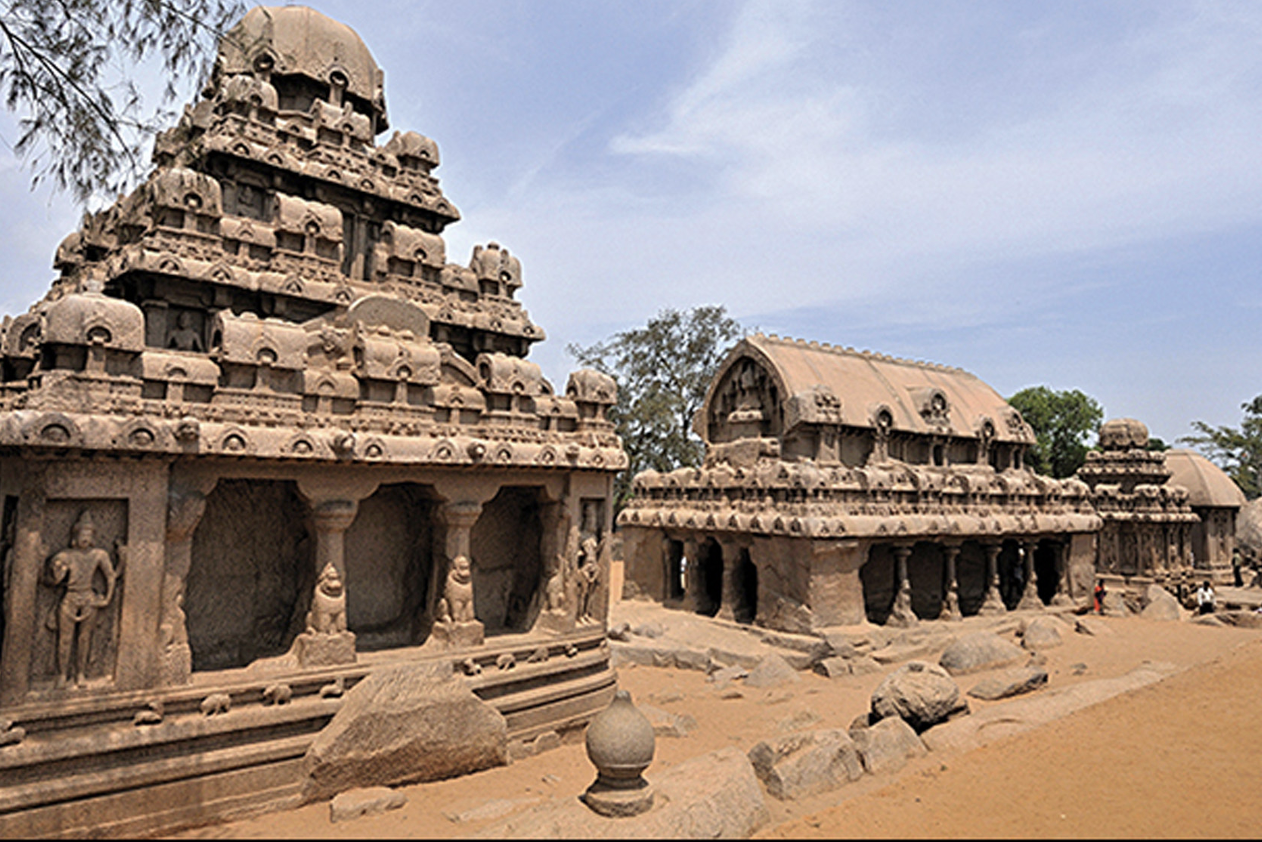
DHARMARAJA RATHA, MAMALLAPURAM
Tamil Nadu, India.
Pallava period, c. mid 7th century CE
-Pallava Period-1 of the 5 Rathas. Early southern style temple. Each story has cornice and a row of miniature shrines, Shrines and cornices are decorated with window motif facing peer. Shrine provide loftiness for palace and enshrine a god. Unfinished Square plan an unhallowed pillared hall therefore like cave temples Dharmaraja Ratha was executed top downward. Lower portion only niches were carved.
-single deity in each niche forecast main trend in temple structure: the tradition of narrative relief declines, stories told concentrated in statues of deities, conjuring mythological episodes through the characteristic poses and symbolic objects. South side is Ratha among deities is two armed King Mamalla and he visually appears to be associated with Shiva. Tradition of depicting royalty in divinity became popular in southeast Asia.
DESCENT OF THE GANGES
Rock-cut relief, Mamallapuram, Tamil Nadu, India.
Mid 7th century CE. Granite
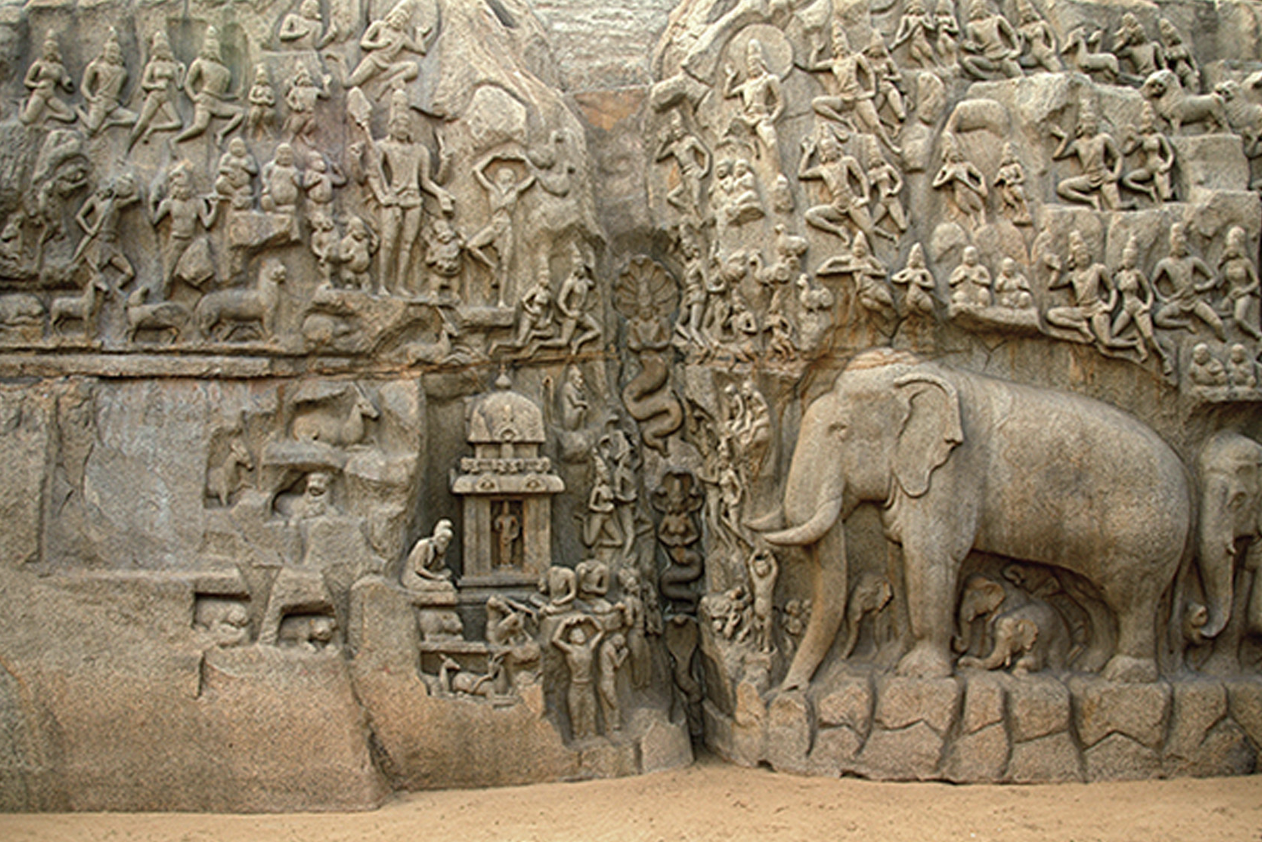
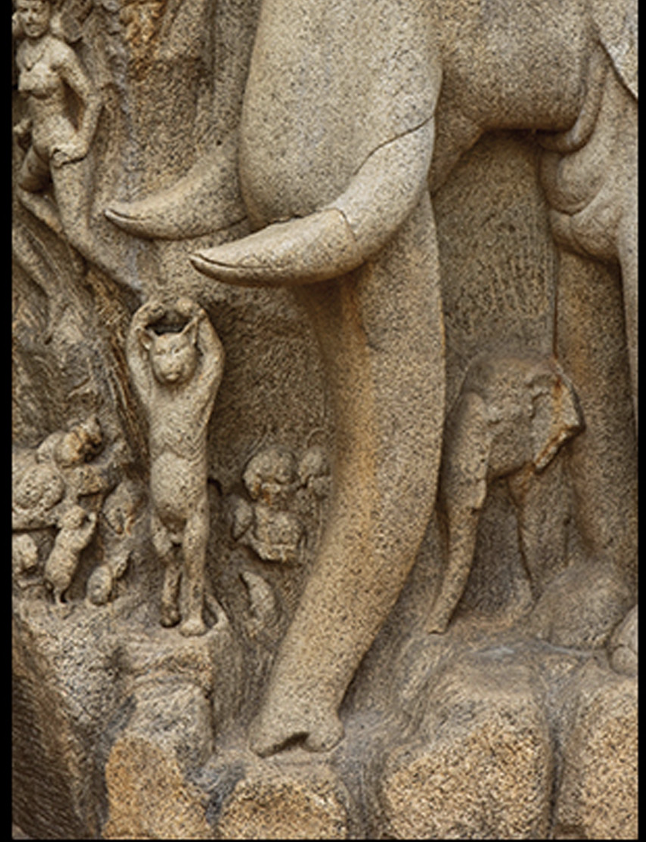
CAT IN YOGIC POSTURE
Detail from rock-cut relief, Mamallapuram, Tamil Nadu, India.
Mid 7th century CE
Pallava Period-
-Slesha (overlapping meaning). Depicts penance of king Bhagiratha who wanted to purify deceased ralative ones by subjecting himself to austerities. In response Shiva sent the Ganges river (presented by natuarl cleft in the rock )to earth allowing holy man to ensure peace to relatives in next lives. Bhagiratha represented staring in sun through his parted fingers, standing on one foot, and deep prayer before temple.
-Upper left is Shiva, four armed, appearing before Bhagiratha to grant wish. Animal families represented as protective roles. Pallava twist is cat imitating Bhagiratha’s pose, referencing aging cat pretending to be ascetic who renounced meat to lure mice into complacency. This cautionary tail about false ascetic serves as apt to upper scene of consummate penance and faith. Both tales et at banks of Ganges..
-Relief executed under pallava dynasty who contniues to flourish in southeaster India until 9th century. Relief visible to anyone heading inland from sea, allegory for kingship.Invokes presence of Ganges river at the heart of Pallava southern empire
describe The Seventh through Twelfth Centuries
Regional styles developed in ruling kingdoms that were generally smaller than those that had preceded them.
Hindu gods Vishnu, Shiva, and the Great Goddess Durga grew increasingly popular.
By around 1000 the Hindu temple reached unparalleled heights of grandeur and engineering.
KAILASHA TEMPLE, ELLORA
Cave 16, Ellora, Aurangabad District, India.
8th century CE
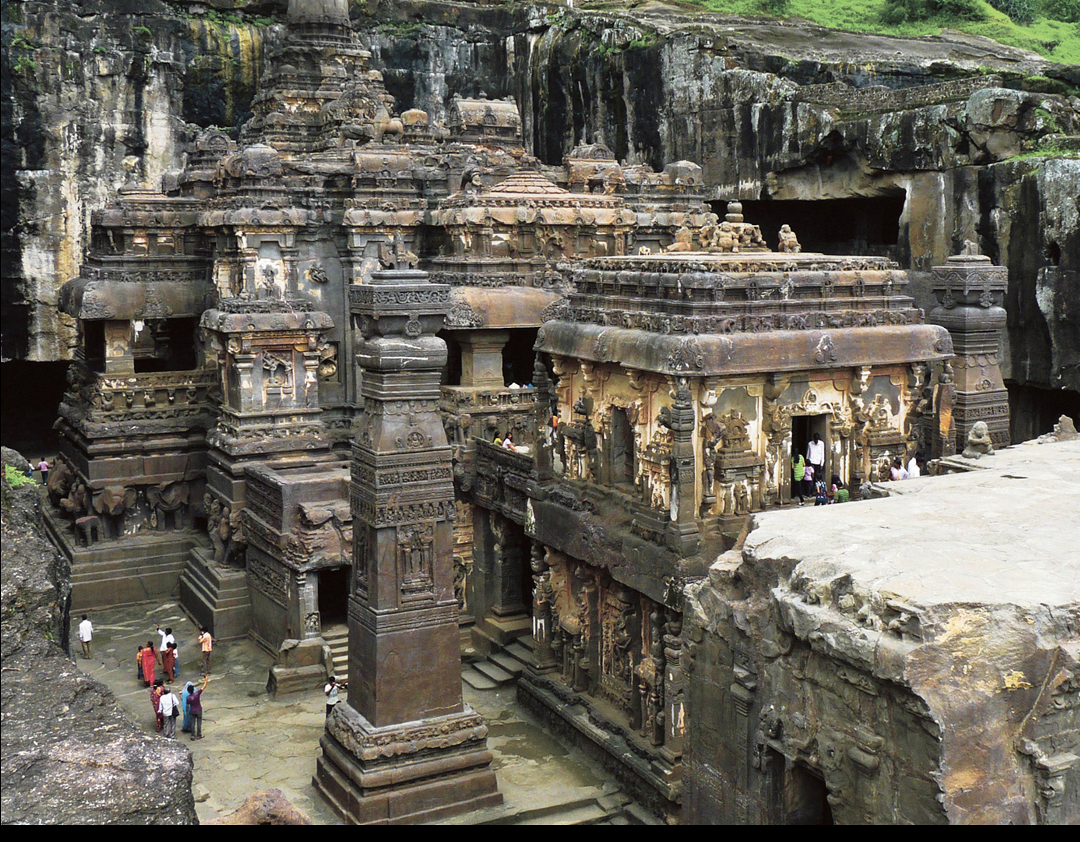
5th-10th century. Rock cut out site. 34 caves total dedicated to Hinduism, Jainism, Budhhism.
-started in reign of Rashtrakuta king Krishna and completed under successors. Marks apex of south Asian rock cut tradition, sculpted 2 story Shiva temple out of one stone, highly ornamented. St back in the mountain site requiring cutting straight down.
-Circumambulate ground level admiring narrative sculptures and elephants at lower plinth. 2nd level with
i
is a Shiva bull mount shrine(Nandi),
-Mandapa is main temple hall, interior within painted narrative imagery.
-garbhagriha can be circumambulated from 2nd stor, lots of shrines radiate. Sculpture alongsigh depict deities and events from hindu literatures, mostly featuring Shiva.
-site is metaphorical between temples and mountains, made from mountain. Named for Shiva’s abode o mount Kailasha in the Himalayas. mountainside better suited for Buddhism and Jainism monastic communities. Location did not fit with Hinduism public nature and ritual requirements. Kailasha is last great rock cut out Hindu temple.
KANDARIYA MAHADEVA TEMPLE, KHAJURAHO
Madhya Pradesh, India.
Chandella dynasty, c. 1000 CE.
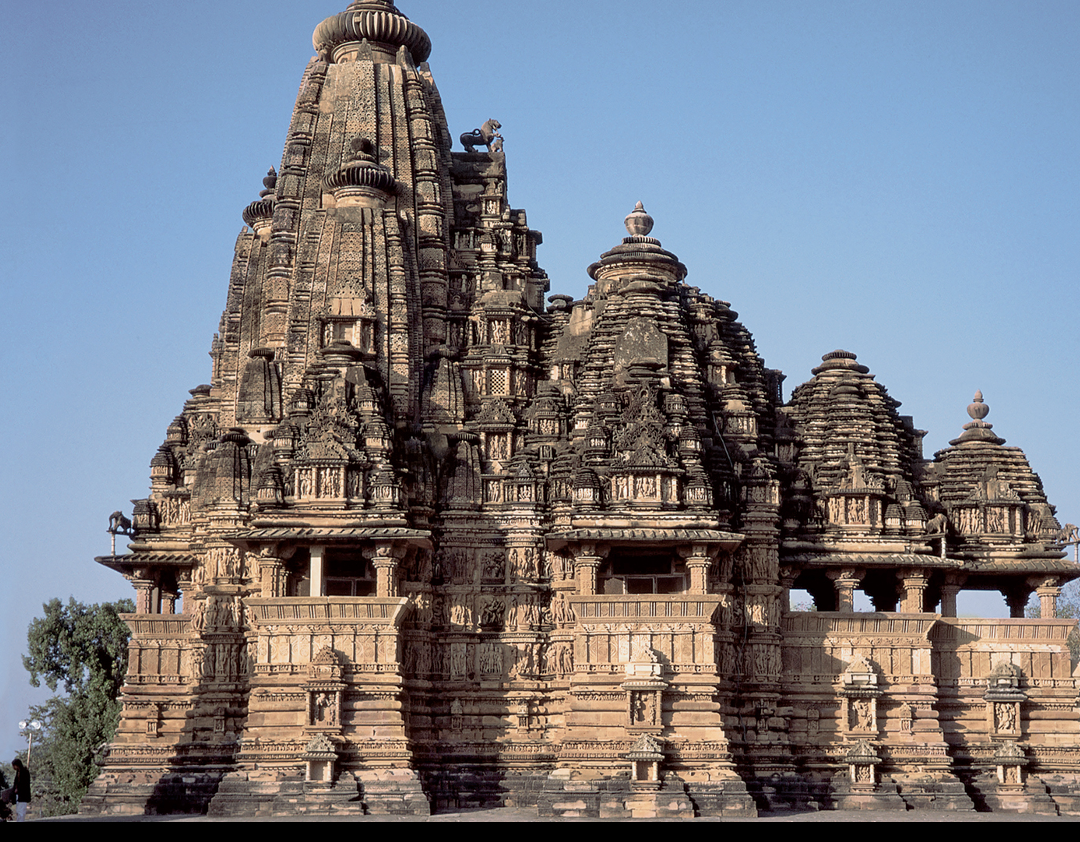

EROTIC SCULPTURES, KANDARIYA MAHADEVA TEMPLE
Detail of reliefs. Height of registers approx. 3'3" (1 m).
Sandstone, c. 1000 CE.
950 ce , Chandella court moved against the Pratihara dynasty, whom were vassals. Chandella rebellion was successful and marked new statues in ambition temple. Earlier temples took Image of Vishnu from previous overlords. Khajuraho remains capital and maine temple for Chandellas over the 80 temples constructed, 25 temples well preserved.
-Dedicated to Shiva built by ruler of chandella dynasty in late 10th early 11th century. Northern style, shikhara rises over garbhagriha of temple, ornamented, halls on front and porches to side and back. Temple on stone terrace and sets off space from mundane world. front staircase leads to 3 mandapas preceding the garbhagriha. Mandapas for rituals like dnaces for deity and offerings. Made from stone block, post-and-lintel. Shikhara crowned by amalaka. Shikhara surrounded by smaller towers, adds richness to surface and obscures shape of main shikhara which is slender and upward movement. Roofs of mandapas impression for rapid ascent and grow taller nearing the shikhara.
-clear structure and unified composition. Strong horizontal moldings(shaped strips), open space over mandapas, porched seperating towers from lower portion. 3 rows of sculptures, some 600 figures, into exterior wall, 3 ft tall, high relief, depict gods and goddesses, and erotic postured figures.
-Khajuraho temples known for erotic sculptures. In single vertical line at the juncture of the walla enclosing the garbhagriha and last mandapa. Uncertain significance, maybe derive from amorous couple mithuna, or 2 growing tradition in hinduism Tantra and bhakti. Growing terms affected hindu art and practices: tantric/esoteric and bhakti/devotional. Both movement evolved through India but tantric appeared primary in north art, bhakti in south Asia. Bhakti revolves around relationship of Humans and deities where as dharam focus focuses on ritual and performances.
-bhakti focuses on intimate, personal,loving relations with god, devotion and surrender to the deity.
-Tantrism, guidance of a teacher and empleye technique to help devote to the deity understanding no seperation between one self and devine.
both traditions at times employed erotic imagery as a visual means of expressing ideas of devotion and unity.
Two major religious movements were developing that affected Hindu practice and art: the tantric, or esoteric, and the bhakti, or devotional.
Buddhism declined in India, but was thriving in Sri Lanka.
PARINIRVANA OF THE BUDDHA
Gal Vihara, near Polonnaruwa, Sri Lanka.
11th-12th century CE. Granite
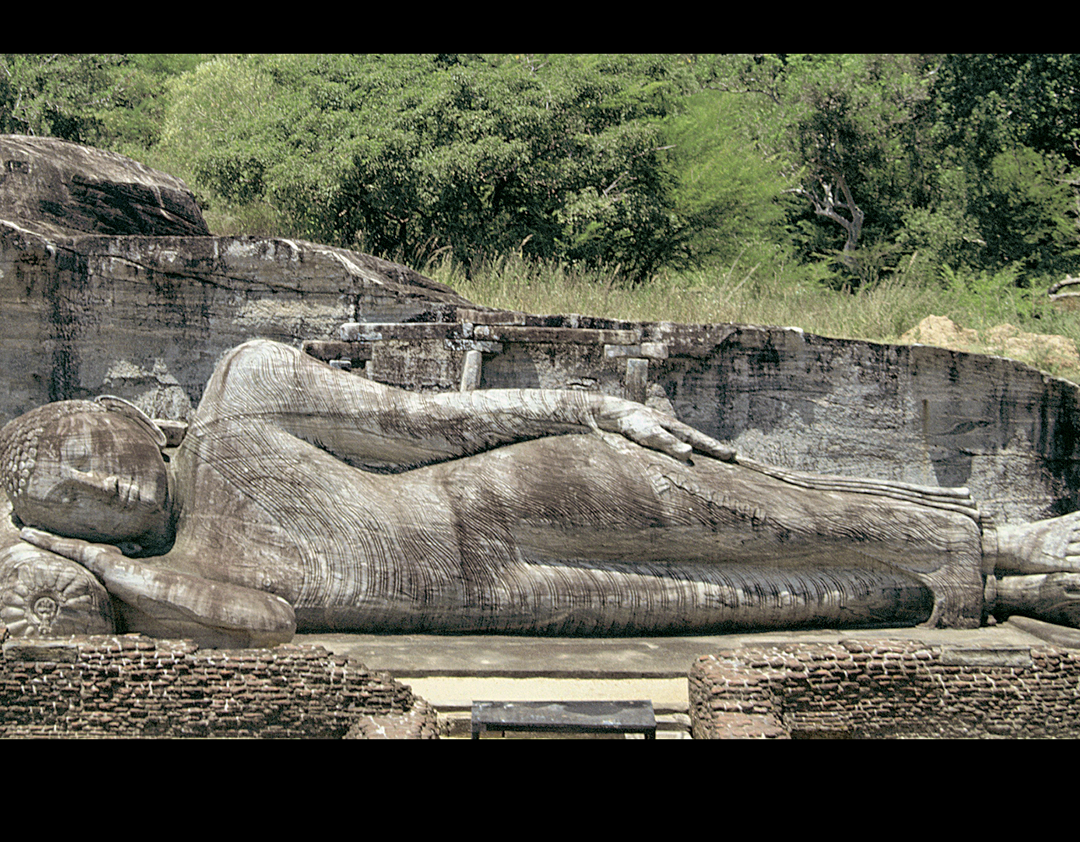
-12th century . Island kingdom played role in exporting Buddhist idea in southeast Asia, close economic and cultural ties. Sri Lanka central maintaining Theravada buddhist traditions, preserving relics and scriptures. Sri Lankan sculptors redefine Buddhist styles and iconography in sculptures but not Buddhist forms. Buddhist image was made during his lifetime therefore intentional change wasn’t necessary/inacurate.
--Gal Vihara -by King Parakramabahu mid 12th century. Rock cut-out, at monastery complex , 1 of 3 colossal Buddhas. Shows early theme of buddhist art of Buddhas final death and transcendance, sophistication of modelling and porpotion localizing classical buddhist tradition. Originally housed in wooden superstructure because of posthole in face . Granite remains. Located north of the capital in Polonnaruwa, occupied until late 1200’s when empire fell.
Describe the Chola period
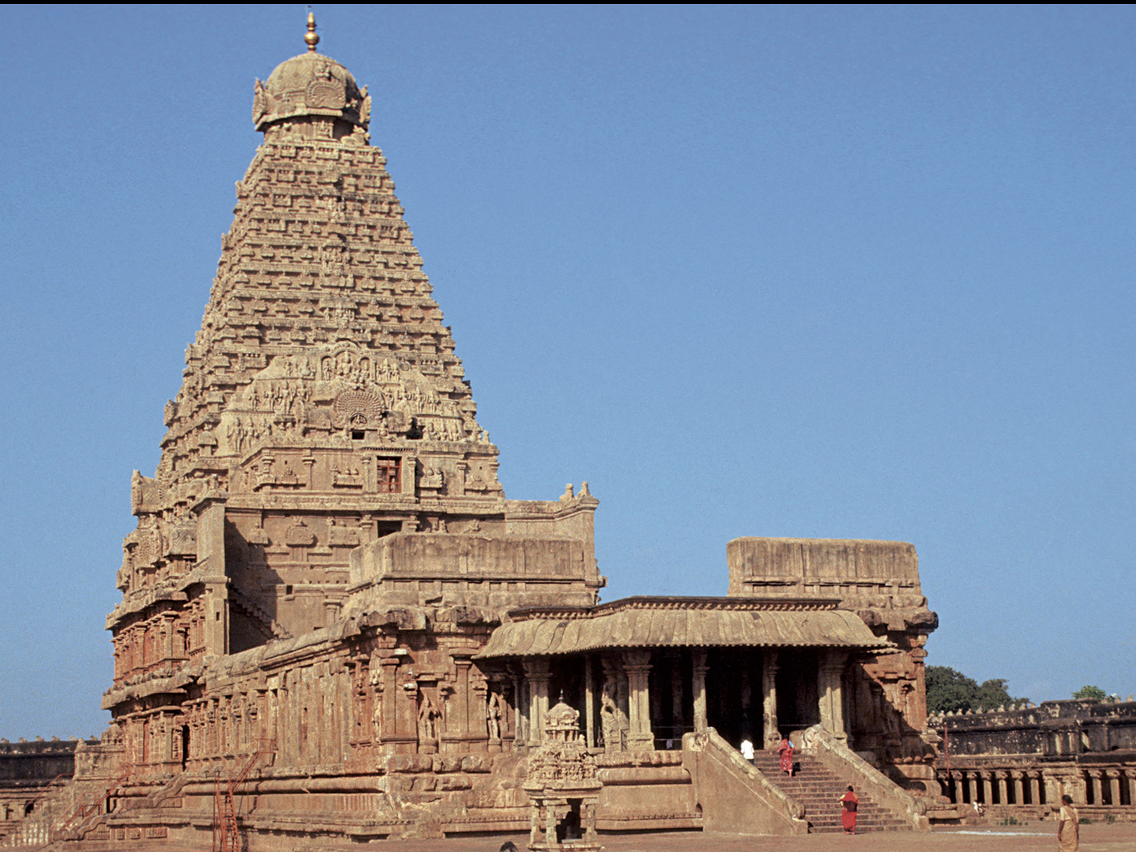
RAJARAJESHVARA TEMPLE OF SHIVA, THANJAVUR
Tamil Nadu, India.
Chola dynasty, 1003-1010 CE.
Succeeded Pallavas, The Cholas founded a dynasty that governed most of the far south of India. Large trade net work and good army.Peak during reign of rajaraja who had many victories in battle, built the temple to Shiva in hi capital, Thanjavur. Shiva Bhakti peak movement. Now called Brihadeshtime temple, southern style Hindu temple. Near Kaveri river, dominating the area. Tallest stricture at the time. Each story with miniature shrine, window motifs, dwarf figures”holding” next story. Longitudinal axis, 4 sided hallow pyramid. Mandapa on south side with flat roof different from pyramid roof on north. Two story sanctrum, each story with cornice. Exterior walls has niches holding statue of Shiva. structure ascends skyward , toped with octagonal capstone. Capstone same size as garbhagriha housed below, envoking a final shrine looking up at cosmic sphere .
-RAJARAJESHVARA “Rajaraja’ lord”, Shiva
-
SHIVA NATARAJA (SHIVA AS LORD OF THE DANCE)
South India. Chola dynasty, 11th century CE.
Bronze
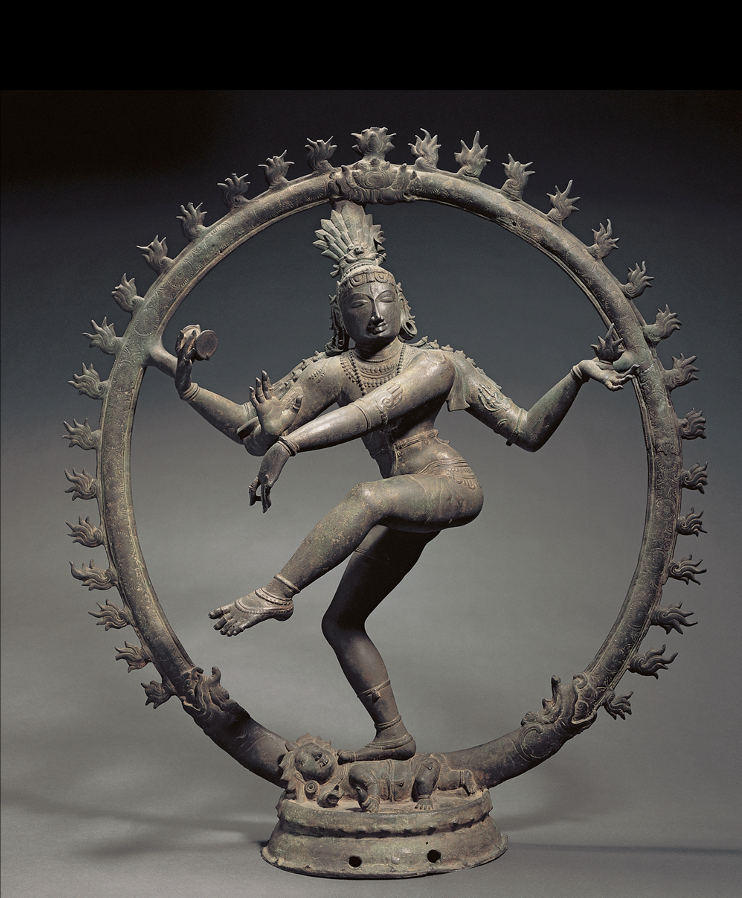
south Indian Chola dynasty, best statue representation of Hinduism. Introduced and promoted by woman named Queen Sembiyan Mahadevi, major patron of temple building and bronze casting, involved Shiva Nataraja. Royal families associate themselves with deities, can be shown between shiva Nataraja and Chola state.
-13th and 14th century represented dance of cosmic proportions, universe cycle of death and rebirth, liberation of the believer through Shiva’s compassion. Iconagraphy shiva has 4 arms dancing on the prostate body of Apasmara (dwarf figure meaning “becoming” and Shiva controls). Extended left hand hold ball of fire(circl of fire ring the god), fire is destruction of samsara and physical universe and destruction of Maya(illusion) and ego centered perception. Shivas back right hand hold drum(beat represents irrevocable rhythms of creation and destruction, birth and death). Front arm show abhaya(have no fear Mudra ). Front left arm across body pointing at raised foot signifying liberation.
-Complex pose with great clarity. Central axis aligned with nose navel, insole of weight bearing foot, maintain figure equilibrium while other limbs asymmetric. Shiva wear loincloth, ribbon above waist, revealing perfect form supple waist. Light jewlery,. mode from lost wax method and shows great skill expressed by Chola artist.
describe early Art of Southeast Asia
Southeast Asia's earliest human settlements formed along the rivers and coastlines.
Bronze(alloy, copper and tin) casting developed early in the region because of rich mineral deposits, at mainland,1500 bce.
Thailand , Ban Chiang, range of bronze tools and jewelry, ceramics. Java found with distinctive bronze-work and site of Dongson shows short-range ocean trade after 600 Bce. 1st centrut BCE expanded tare an evidence for kindogm named Funan . Trade increased and southeast Asians found controlling between east Asia and point west. Abundance of spices and produces and hardwood, therfore new ideas and 6th century CE evidenc of Buddhism and Hinduism had firm rot in the Mon kingdom of Dvarati(Thailand) and Pre-Angkorian art of Khmer(Cambodia).
STANDING DVARAVATI BUDDHA
Mon Dvaravati style, from Thailand. 8th century CE. Bronze,
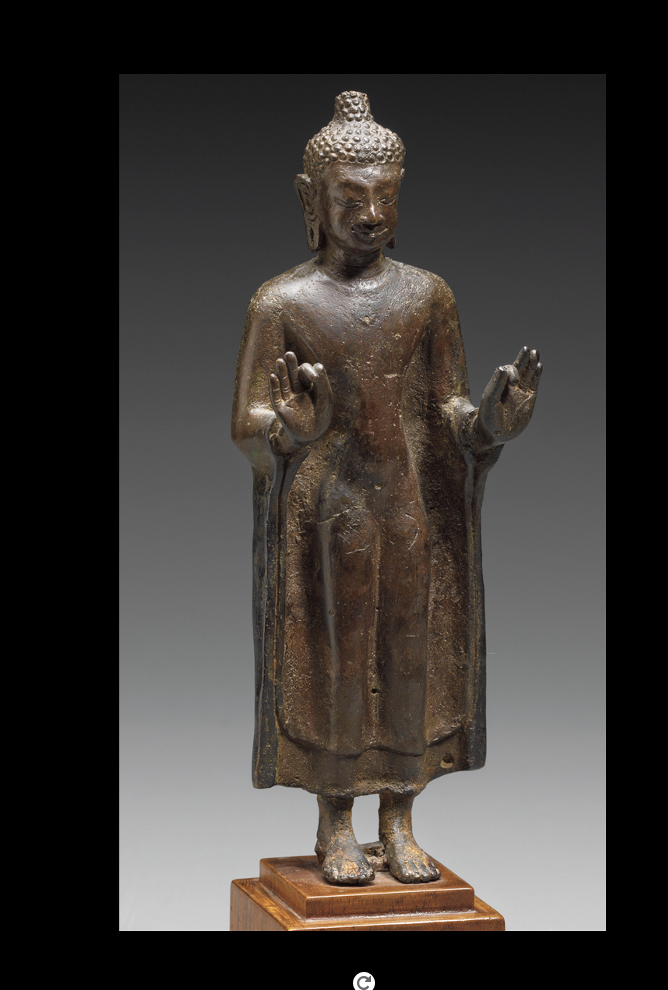
6th-9th century. Trade Network increased in south Asia AND FOREIGN GOOD MORE ACCESSIBLE. Buddhism AND hinduism gained scale and kingdoms emerging, dynasties also emerging and intertwined with early southeats asian concept of king ship.
-Mon ethnic group 1st to adopt Buddhism in South east Asia. 6th century organized in Dvaravati kingdom, name is know by ritual coins found from stupa in Nakhon Pathon, Thailand. Finds varied in form, media, subject because Mon controlled region until khmer came 10th cent.
-Arched brows, outline face features, curled hair like Mathura style, double robe flattened in distinctive manner against body ,capelike. Iconography consistent in South Asia, but statue displays same mudra in both hands, vitarka. Uncertain reason for symmetery but suggest local preference. Small size image inspired by small icons along trade routes
HARIHARA
From Angkor Barei, Cambodia. Pre-Angkorian Khmer, 7th century CE.
Sandstone,
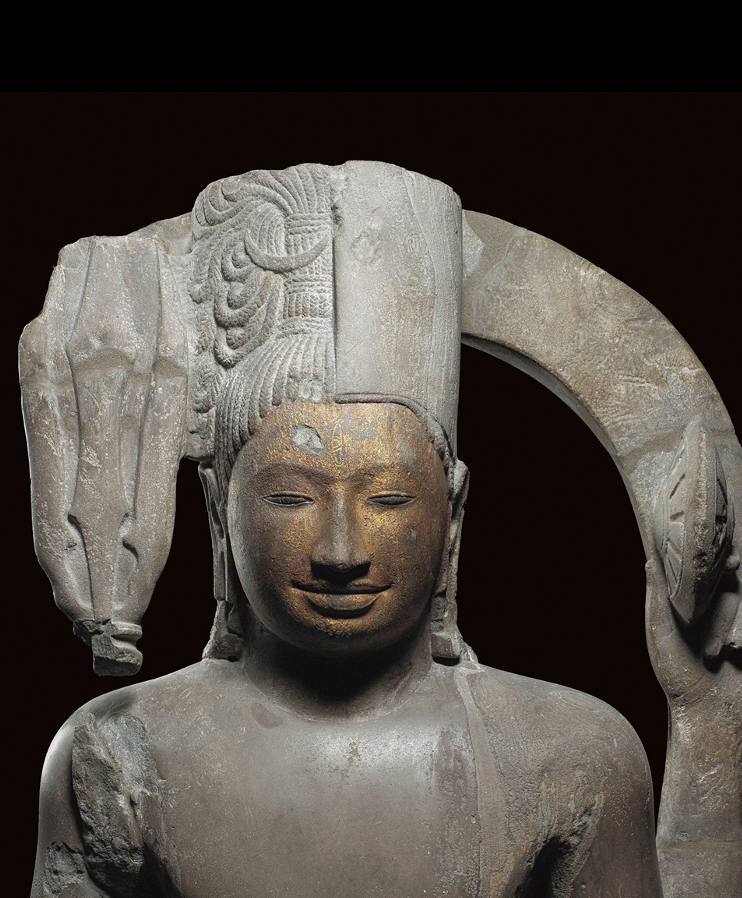
-Local preference Ex. Depict Shiva and Vishnu, rarely encountered in South Asia but in South east Asia very popular. Unification of Hindu gods. Right side Shiva with trident, matter hair, 3rd eye, , animal skin. Left half, cylindrical crown, chakra, garments. Khmer didn’t trust stone therefore linked hands to head with arch of stone.
BOROBUDUR
Central Java, Magelang District, Indonesia. c. 800 CE.
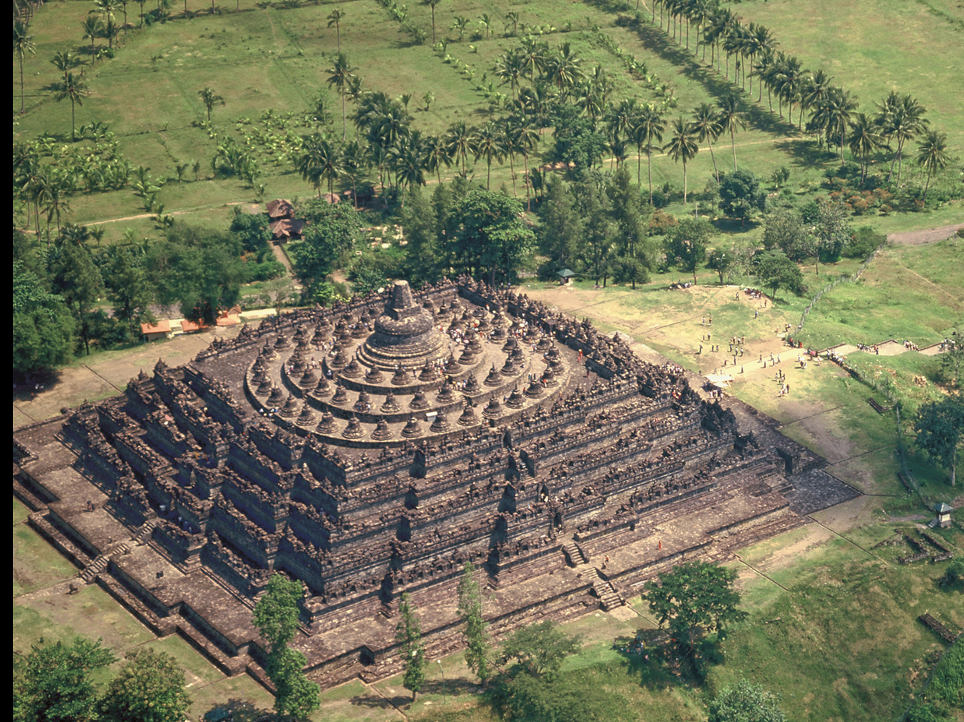
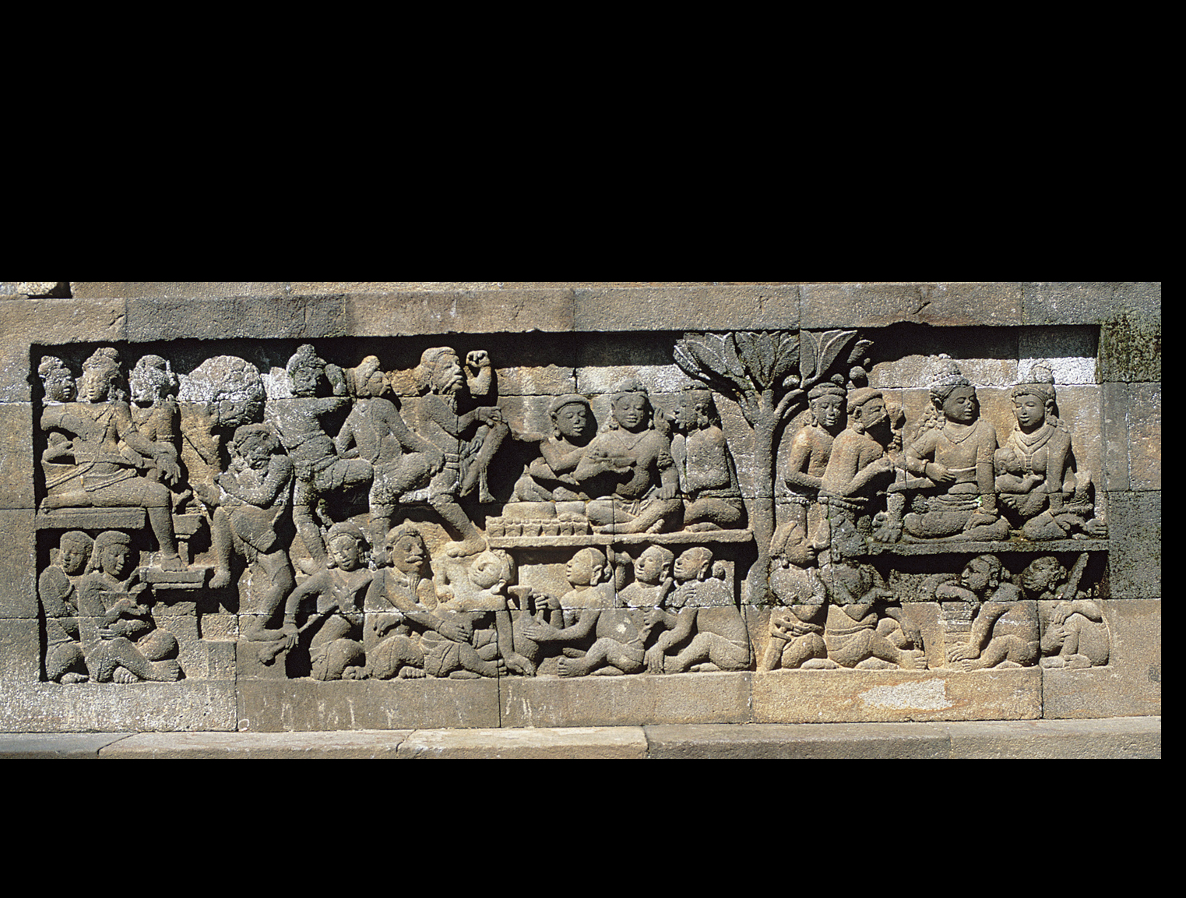
SCENE OF DRUNKENNESS AND MODERATION
Borobudur, east side. Central Java, Indonesia.
9th century CE
-Islands of southeast Asia earliest and grandest responses to imported Buddhist ideas. By Shailendra dynasty year 800. Endpoint of road at Mendut and Pawnon. . Like stupa and 3 dimensional mandal/cosmic diagram but structure still entirely understood.
-100 ft above ground, stepped pyramid of volcanic stone, 5 lower quadrilateral terrace support 3 circle terraces above with bell shaped stupa ringed with 72 smaller stupas. Each terrace surrounded with wall of relief sculpture and adorned buddha images niches and bell shaped projections. Decor on lower level was hidden for centuries because after it was built added foot was put to stop structure from spreading.
-Restoration in 1975, bas reliefs were exposed, .Sculptures with elegant figures, full round smooth bodies with adornments.
-calculated arrangemnts moving from base moral lessons up to abstract religious ideas. Lowest gallery that was covered depict instructive scenes of karmic reward and punishment. Circumambulates to next terrace with scened of Buddhas past lives and other tales with stories of Shakyamuni Buddha. Terrace 4 and 5 with story of Sudhana, a man seeking personal enlightenment and achieving it with guidance of bodhisattva, visitor then exit to 3 upper terraces with rows of stupas and wide vistas, metaphor for enlightened state. sStupas hold seated buddhas except for large stupas where is solid. Dif Buddhas with diff mudras correspond to arrangement in mandalas and another meaning.
LORO JONGGRANG
Prambanan, Central Java, Indonesia.
9th century CE
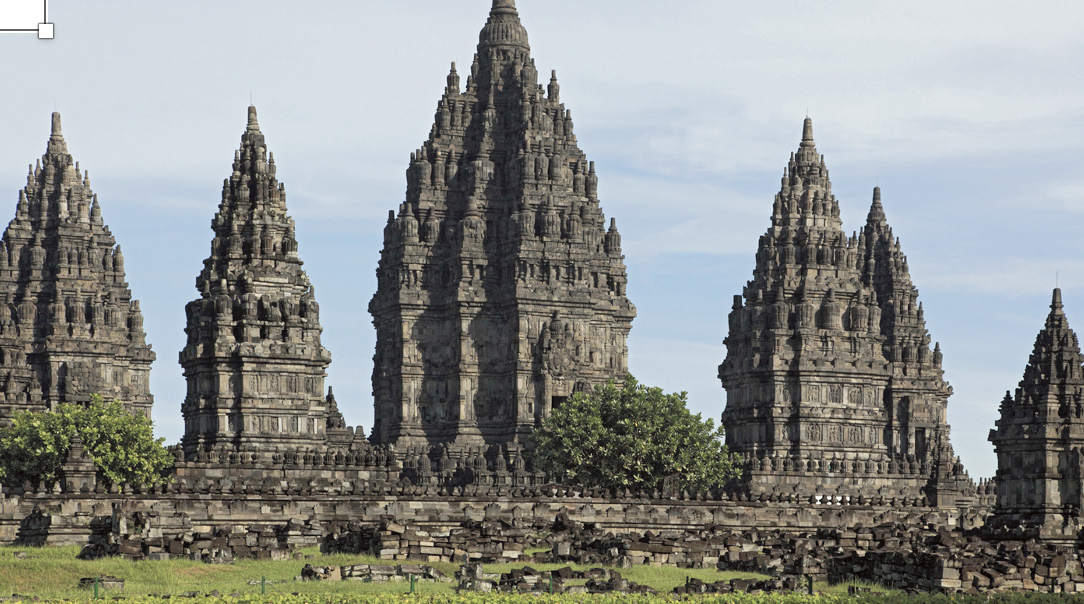
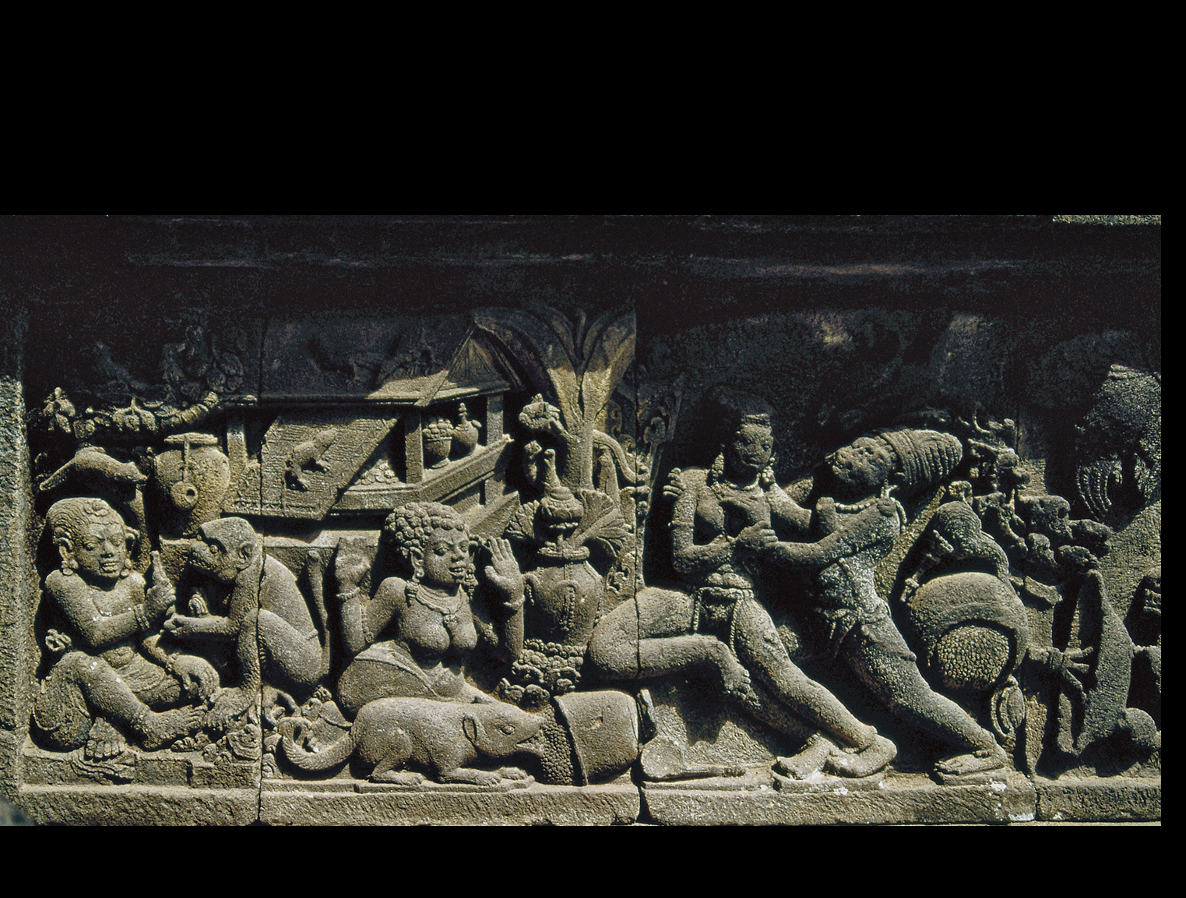
-slight later than borobudur but inspired by it. concentric plan and shares borobudur’s repetition of bell shaped forms. Started in mid 9th century by Sanjaya dynasty rivals to Shailendra, under reign of Rakai Pikatan.
-buildings i complex surround central temple for Shiva. Central sacred area housing biggest temple is enclosed by outer wall which beyond has 224 shrines in 4 concentric squares, shrines now damaged and unclear function but may reflect social statues of donors. Towering central structure 155 ft high is flanked by 2 smaller structure dedicated to Shiva and Brahma, 108 ft. Primary image of Shiva is anthropomorphic rather than linga, surrounded with deities associated with Shiva. Flnking temples have one chamber with carvings of Vishnu an Brahma. Row of 3 smaller chamber across entrances to main temple. Building dedicated to mounts(vihana) of 3 gods, but only Shiva mount(bull Nandi) survived. All temples raised on plinths with relief scenes.
-Scenes from Ramayana , Hindu epic known in Indonesia but made to suit Southeast Asian audience. Local influence, portraying wicked demon king Ravana abducts Sita wife of Rama. Ravana disguised as Brahmin seizes Sita in the midst of a javanese village and overturns object as witnesses are surprised. Wildlife is distracted; dog grabbing food fallen from poy; rat sneaking into storehouse ;monkey reached for food from seated man→ details not mentioned in text shows shamefull animalistic nature of Ravana’s actions that lead to own destruction. Java art is full of activity, event with host of attendants , onlookers and references to natural world.
describe the Tenth through Twelfth Centuries
By the tenth through twelfth centuries, the powerful kingdoms in Angkor and Bagan were reaching their peak.
ANANDA TEMPLE
Bagan, Mandalay Division, Myanmar.
11th century CE.
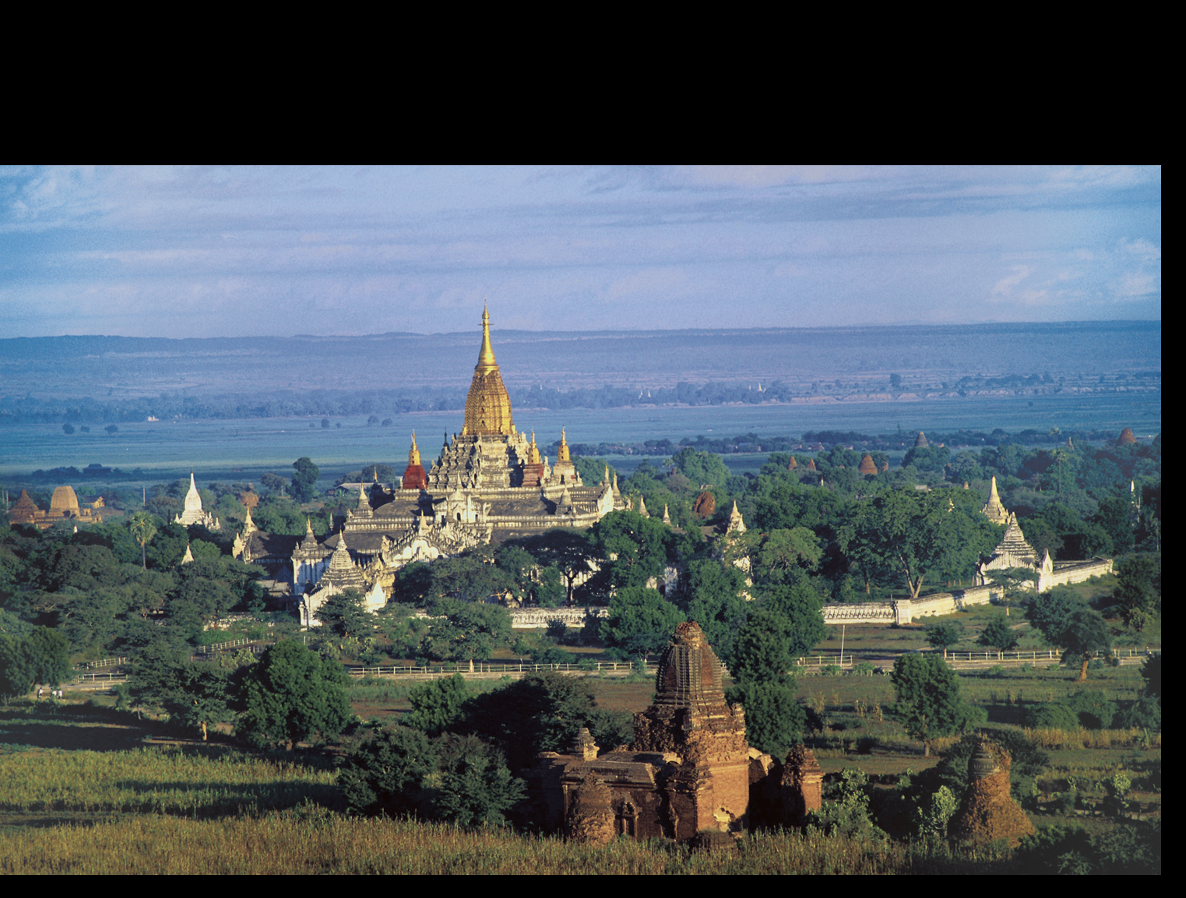
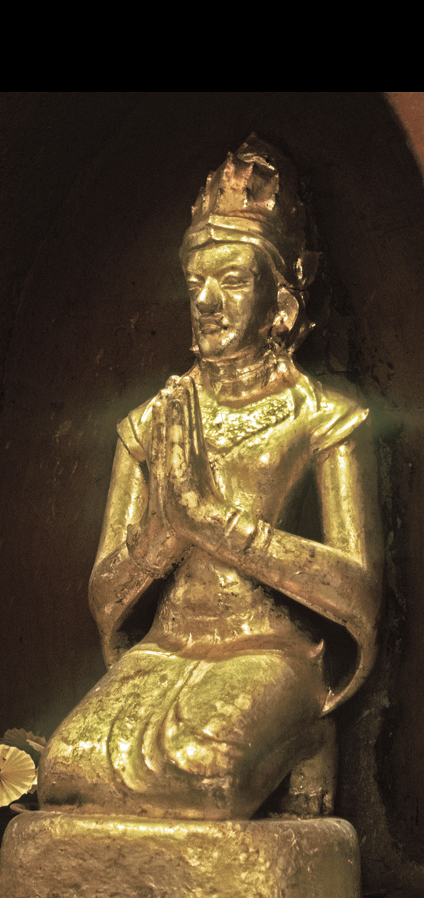
PORTRAIT OF KING KYANZITTHA
West shrine, Ananda Temple, Bagan.
11th century CE. Gilded lacquer.
-King Anawrahta power in 1044, uniting ruler in nothern Myanmar under his rule and gods(nats)under buddhism.
lavish temple-building projects were not just a means for the king to demonstrate his legitimacy and accrual of good karma, it was also seen as means of ensuring the welfare of state interests and public well-being. Focused on monastic order based near Bagan. Over centuries public and royal came to house buddhist structures.
-built 1105 by king Kyanzittha. Head Monk(Shin Arahan) introducted kings to 8 monks from India for support abroad. king undertook act of patronage which how Anada came to be.
-4 temples placed against the side of a large square based Stupa, 175 ft. tEMPLES FACE CARDINAL DIRECTION, HOUSE large Buddha images covered in gold leaf , walls of temples have openings to make way for 2 circumambulation paths. Sculpture in niches remains no painting do. Exterior with rising spires and flamelike decor over doors and window. Central roof raises to main tower in 5 tiers, decorated with horizontal bands of inset glazed ceramic plates displaying buddhas past lives.
-two gilded lacquer images of figures flanking buddha image in west facing shrine, depicting king Kyanzittha, shown in elaborate attire, his cheif monk sin Arahan is bald and in robe. Deatil obscured by layered gold leaf but protected by lacquer.
Ananda one of many grand temples in Bagan, but other structure inacurately restored.
ANGKOR WAT
Angkor, Cambodia.
12th century CE
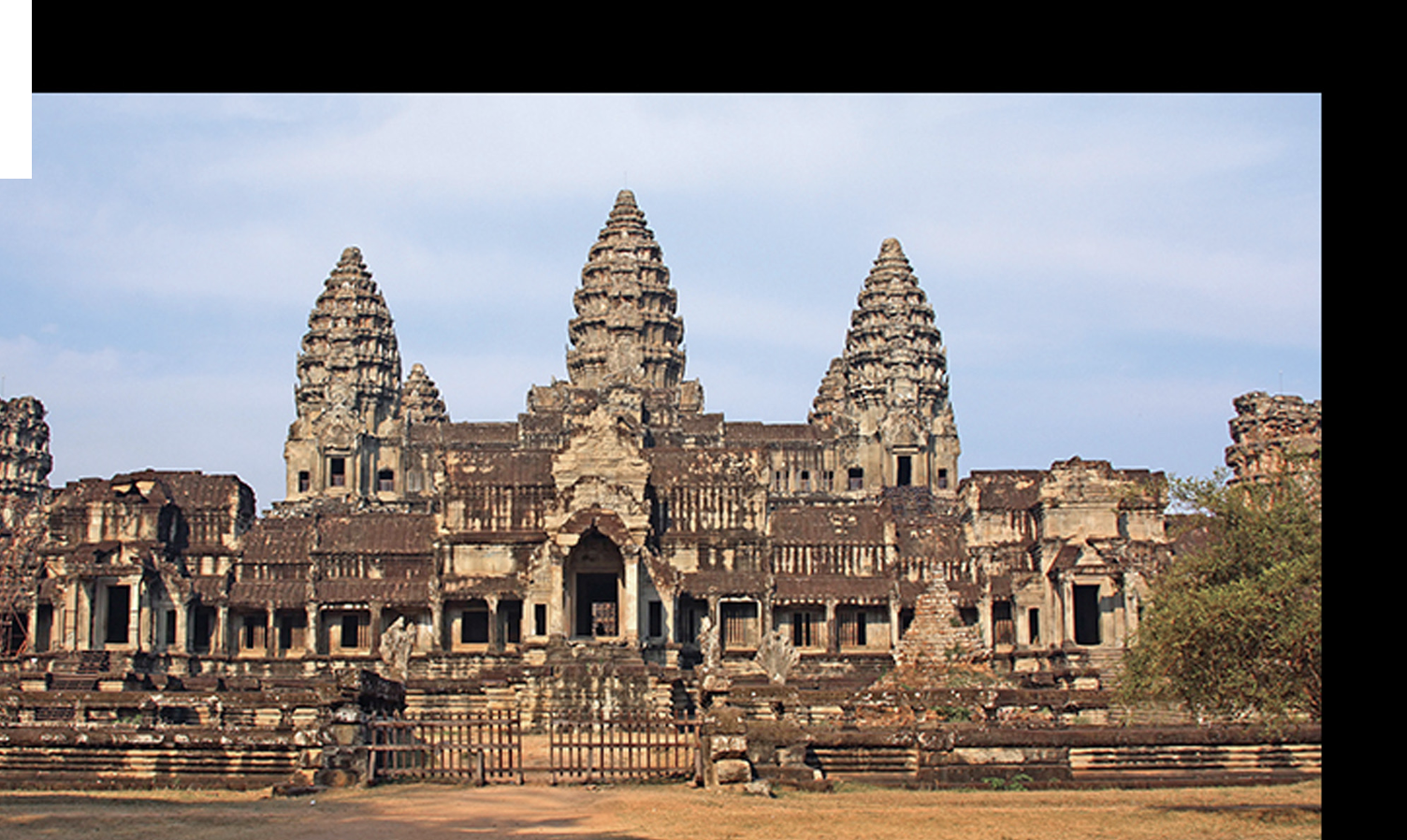
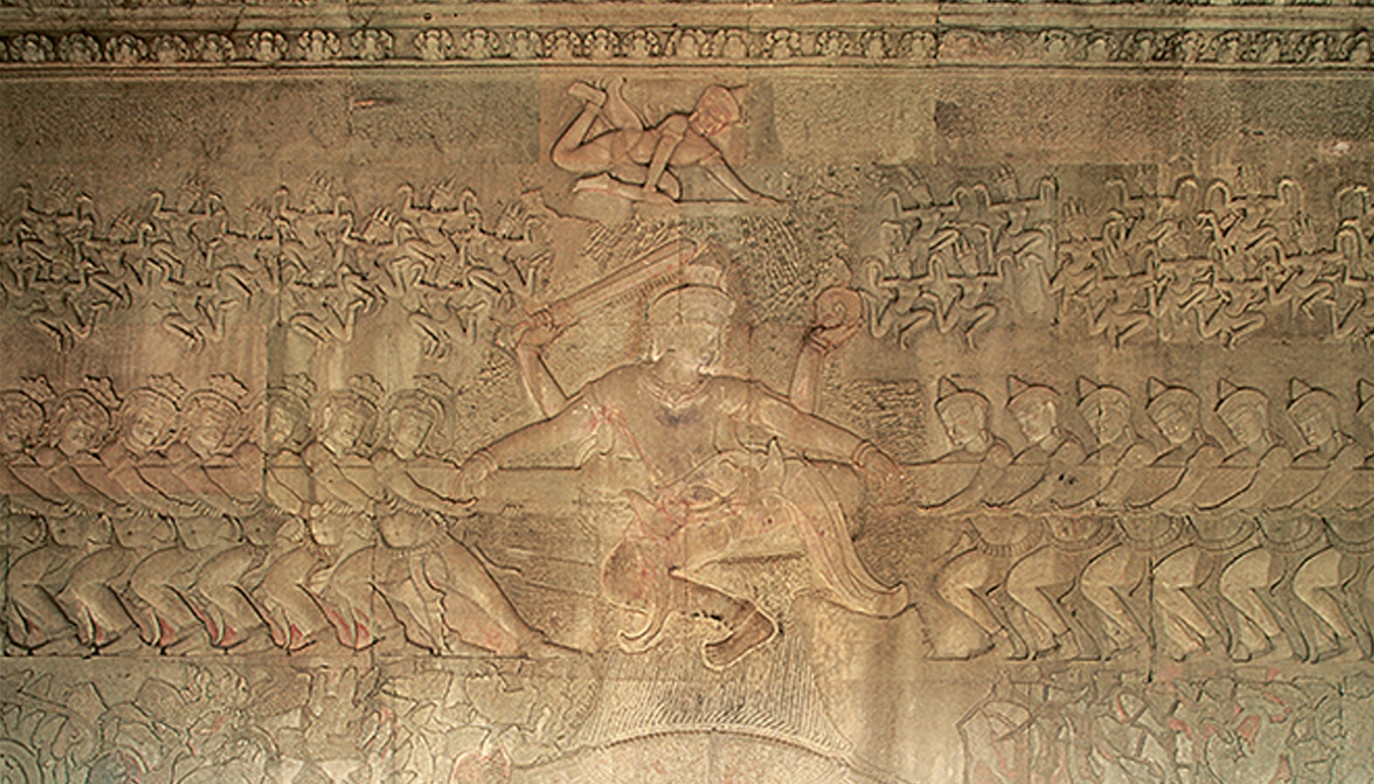
VISHNU CHURNING THE OCEAN OF MILK
Detail of relief sculpture, Angkor Wat.
12th century
-801 Khmer King Jayavarman 2 , retuned from Java climbed mount Kulen, accompanied by Brahmin who perform ritual on mountain top to mark relationship between Jayavarman 2 and Shiva, claiming “god-king” title(devaraja). His descendants constructed temple near urban center of Roluos ad Angkor. Structures recalled the sacred mountains on which the gods dwell and marked the political and religious center of Khmer empire.
-Angkor wat- Suryavarman 2 temple mountain, he came to power 113-1150 after period of turmoil, chose to devote himself to Vishnu rarher than Shiva. Temple facing west towards sun having a funerary association. Temples comprised of 3 concentric galleries that frame stepped pyramid crowned by 5. tapered towers. Structure surrounded by lake-like moats over 820 ft wide, crossed by walk ways adorned with balustrades shape with multi-headed serpents.
-inner walls of 3 of outer galleries have bas-relief sculpture depicting scenes from Hindu epics or glorified depiction of the king. East side of outer gallery potrays Hindu story “CHURNING THE OCEAN OF MILK”. Tale set before world was fully formed, Vishnu orchestrated the of the elixir of immortality, this is achieved by wraping the great serpent around a great mountain merging form sea, then by pulling on serpent the gods working with their enemy(asura) churn up the elixir of immortality from ocean depth. relief understand monument as whole. Mountain-like towers, broad moats, serpents balustrades, complex parallels setting of the legend and speak to Suryavarman 2 hope to gaining immortality through special union with Vishnu.
-